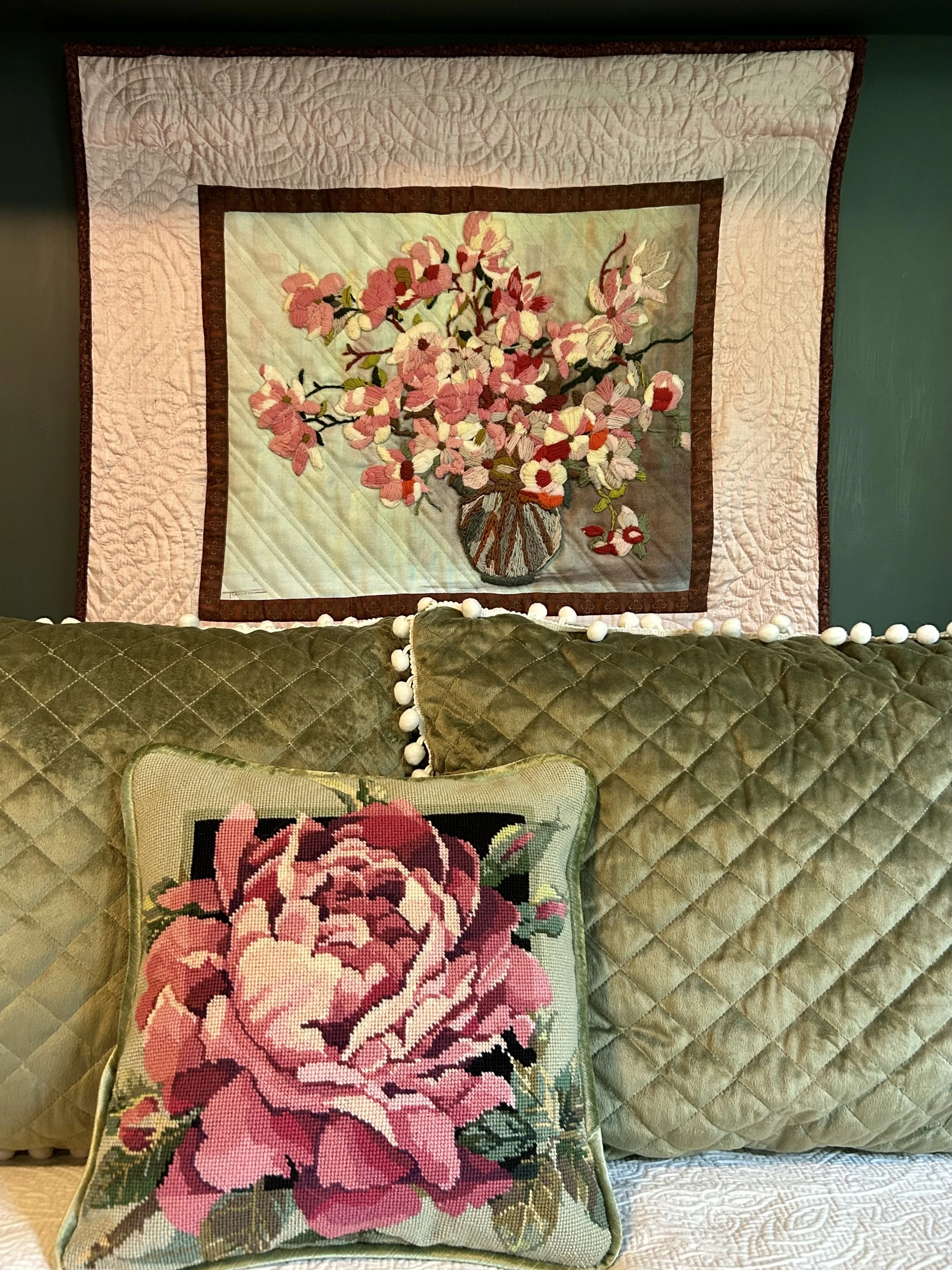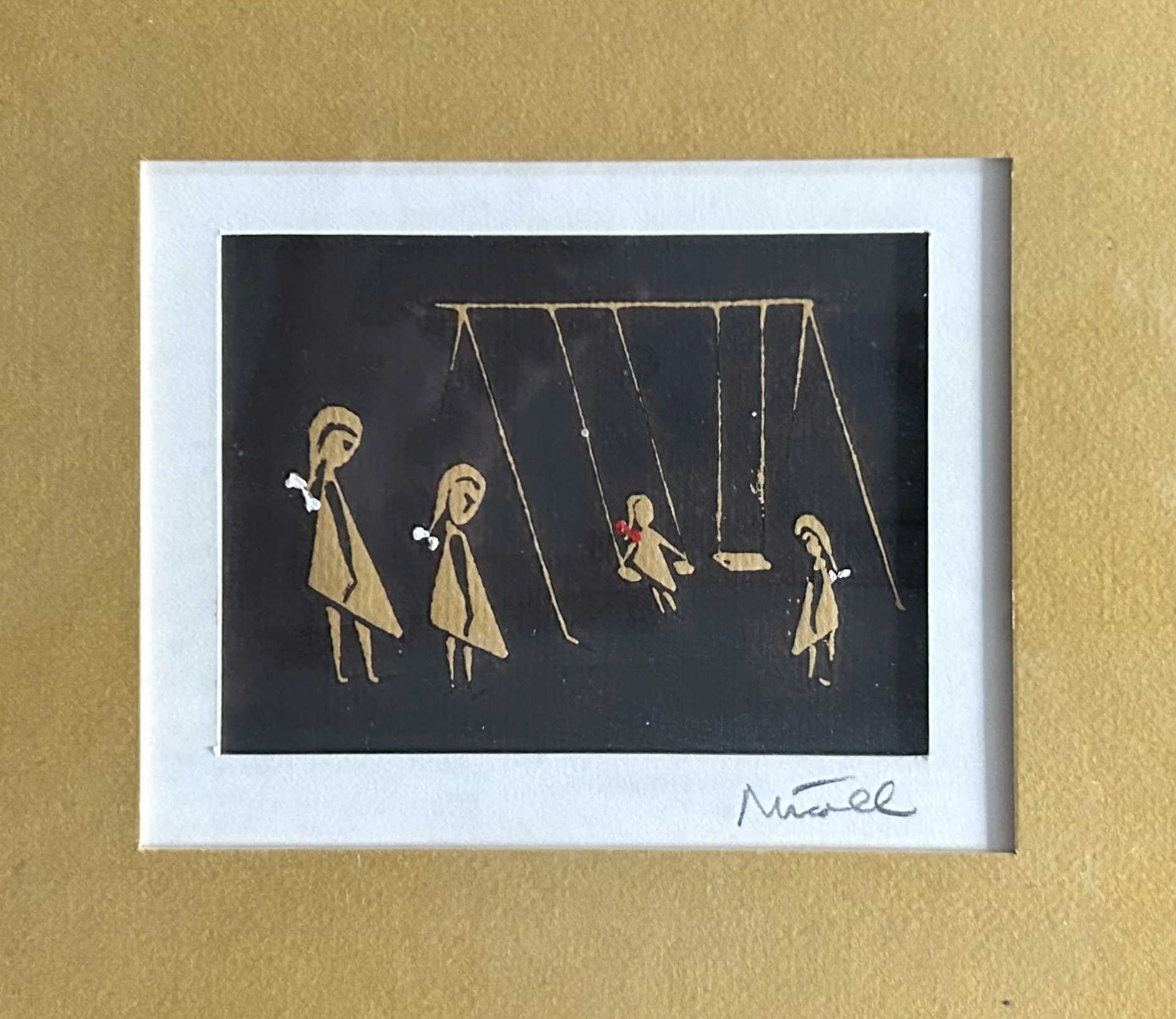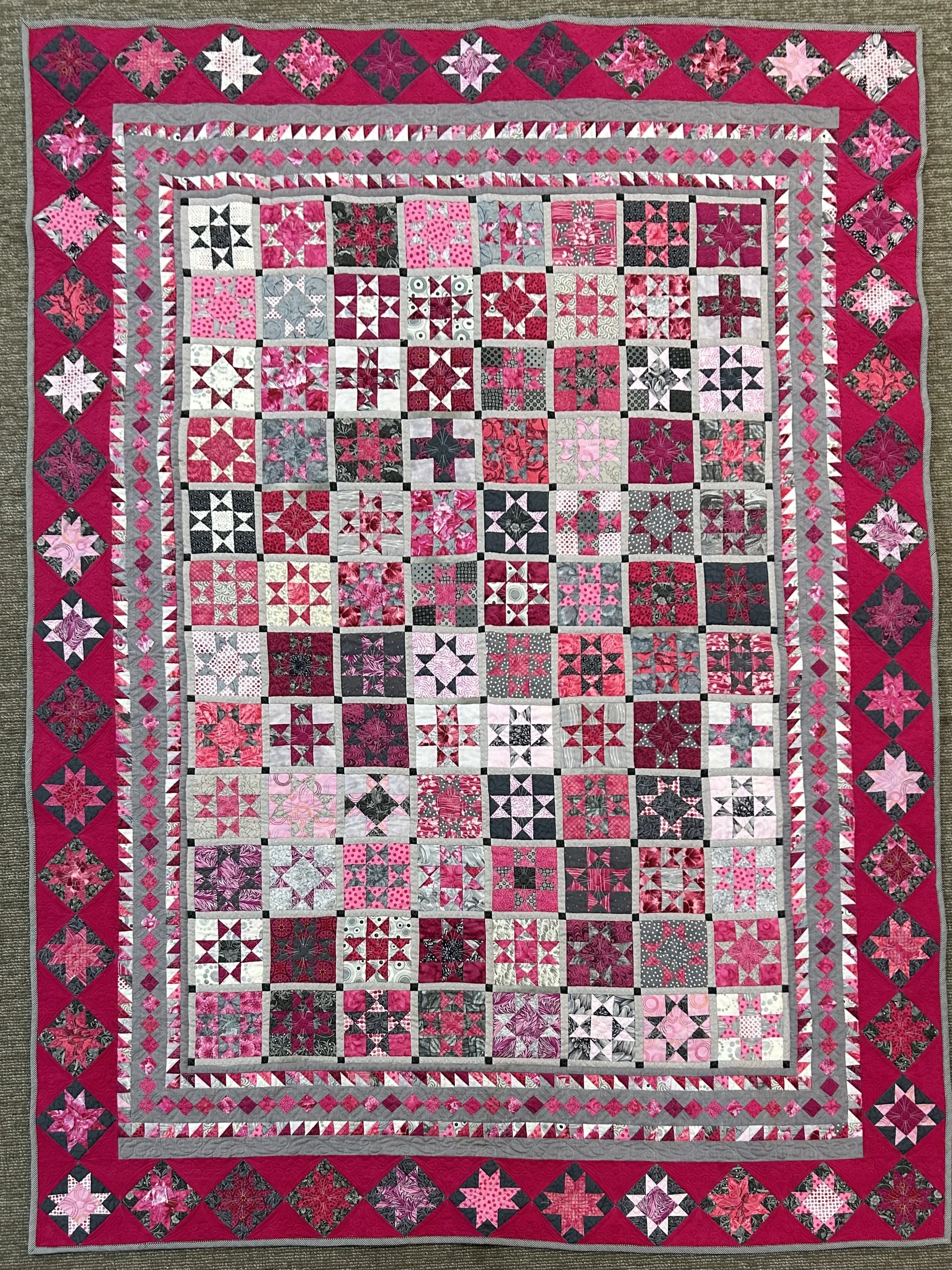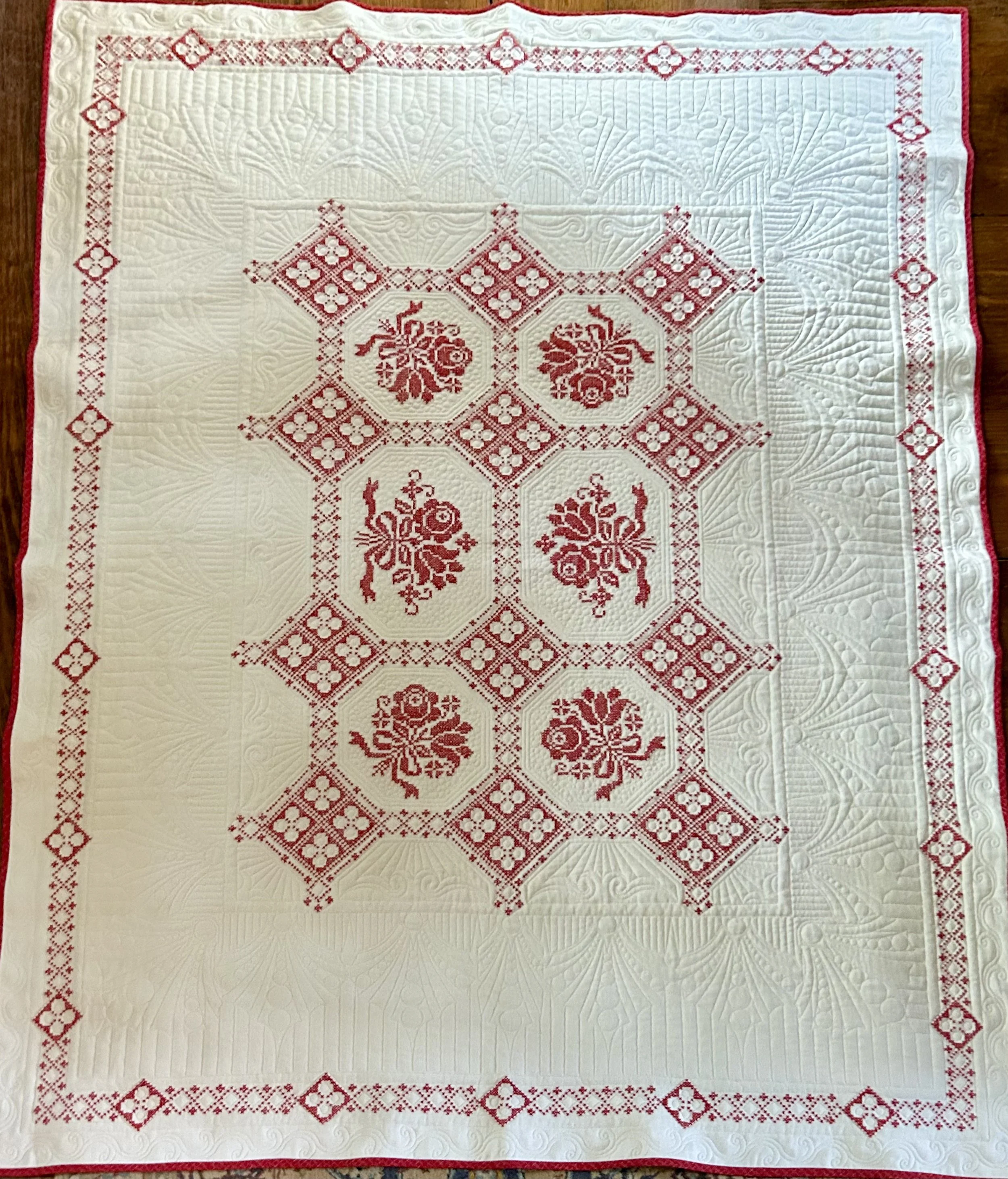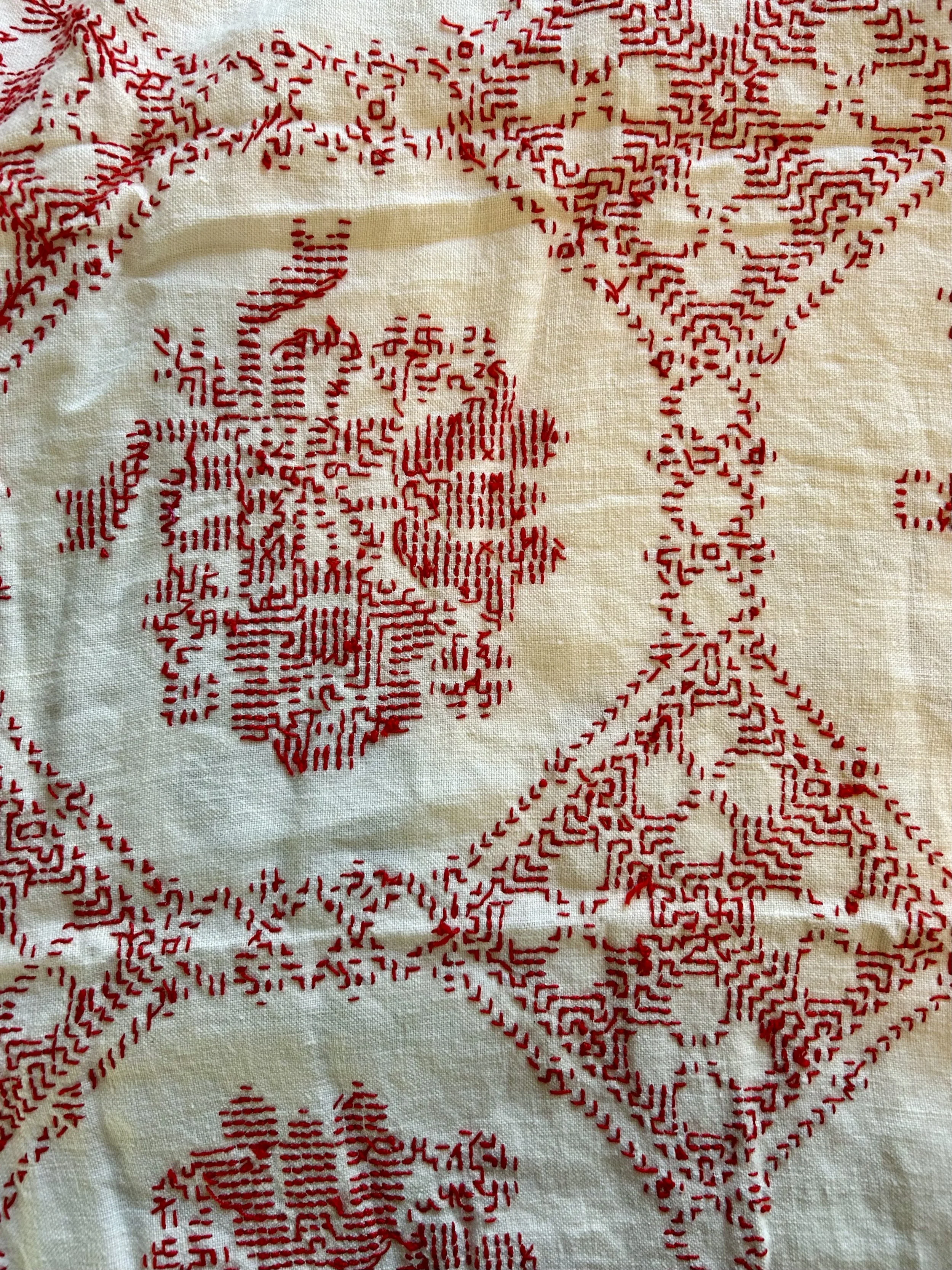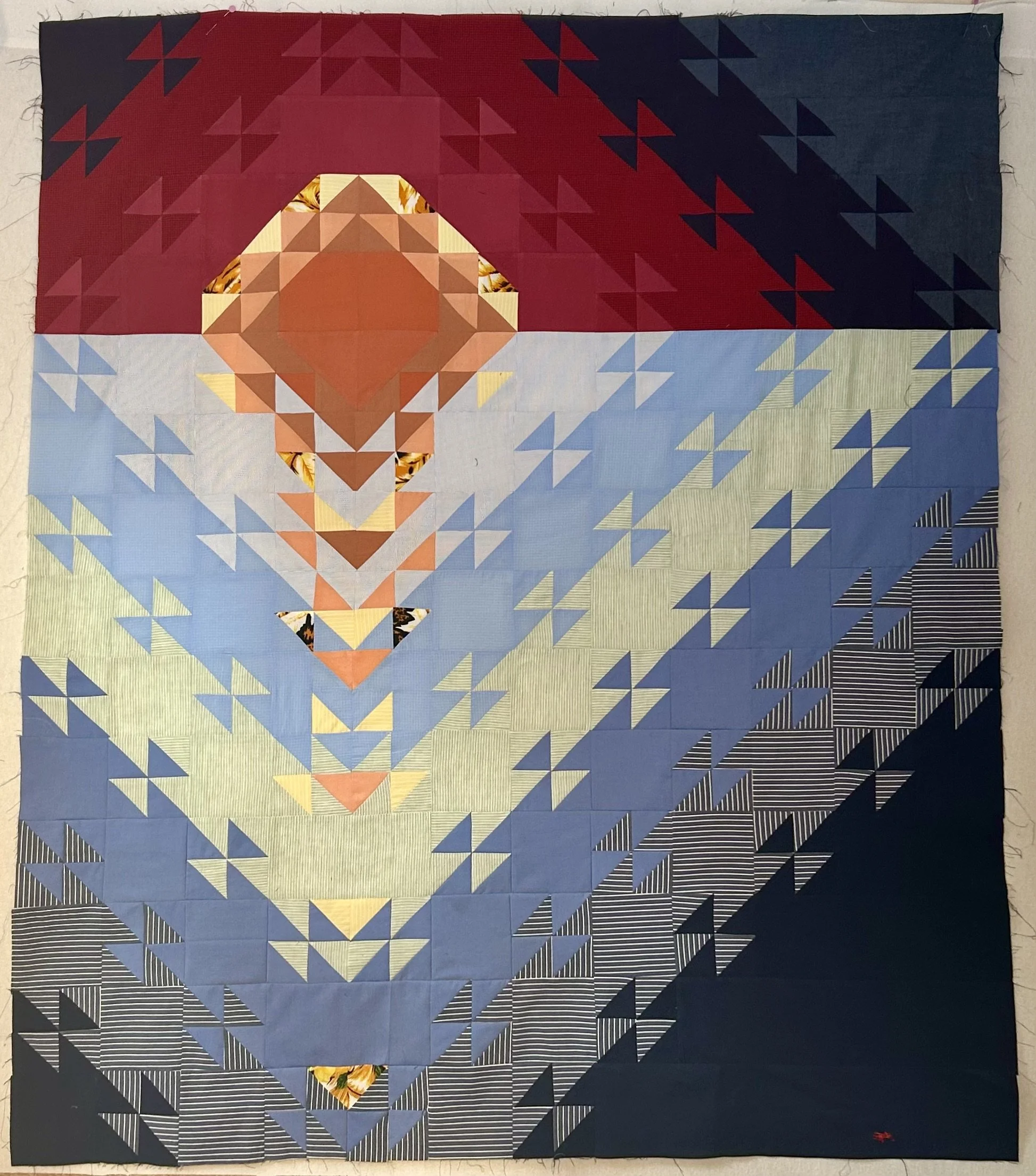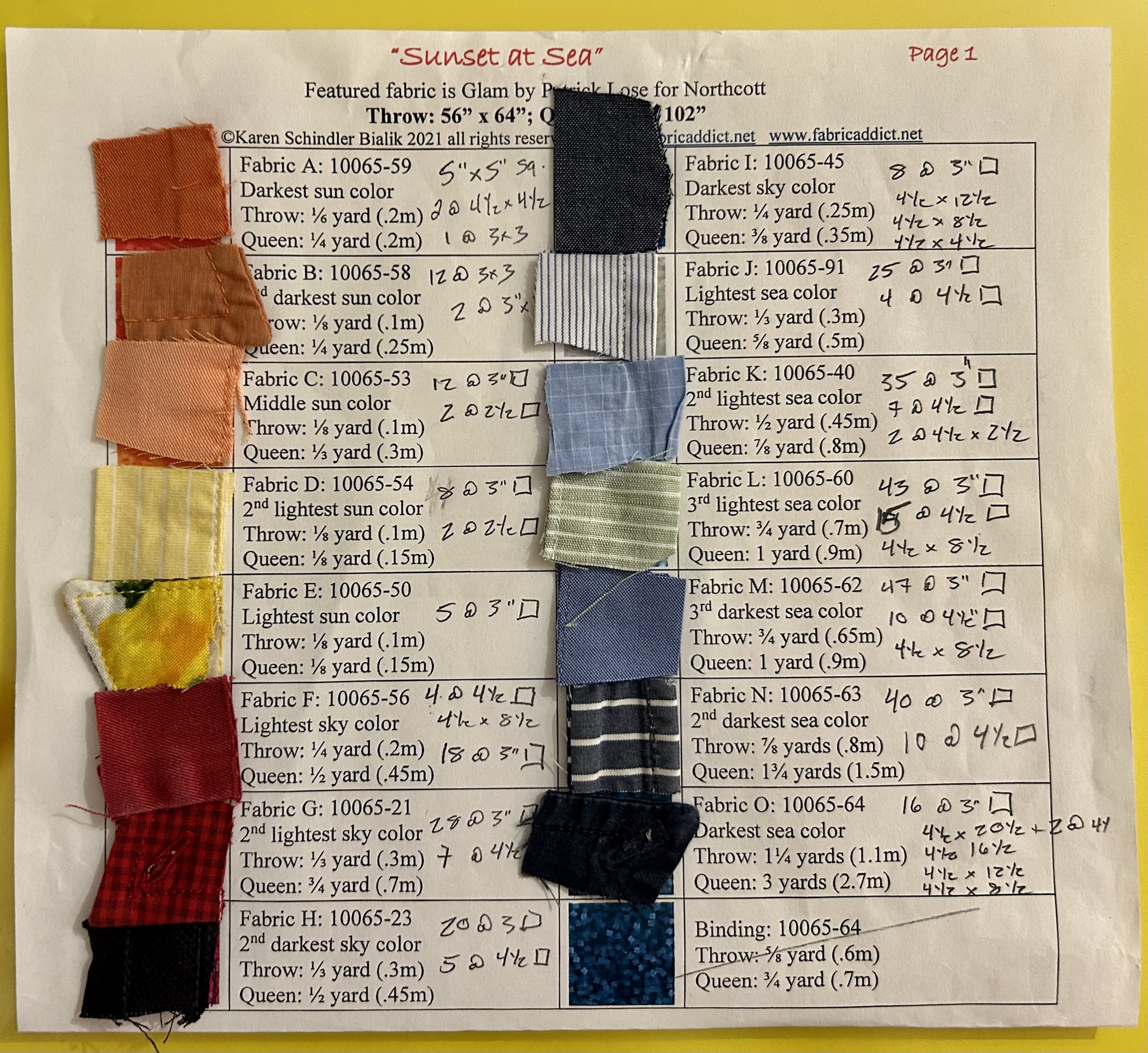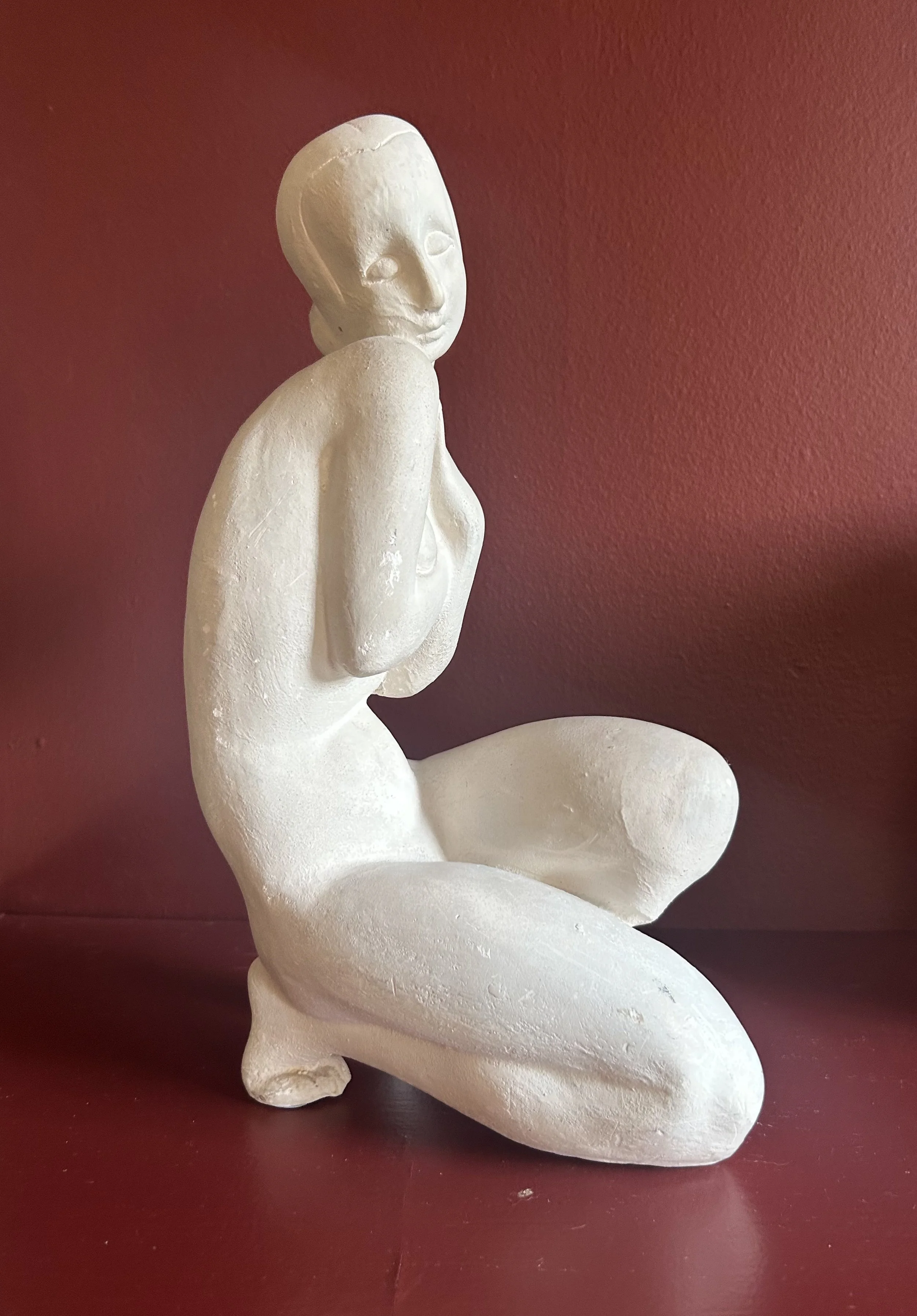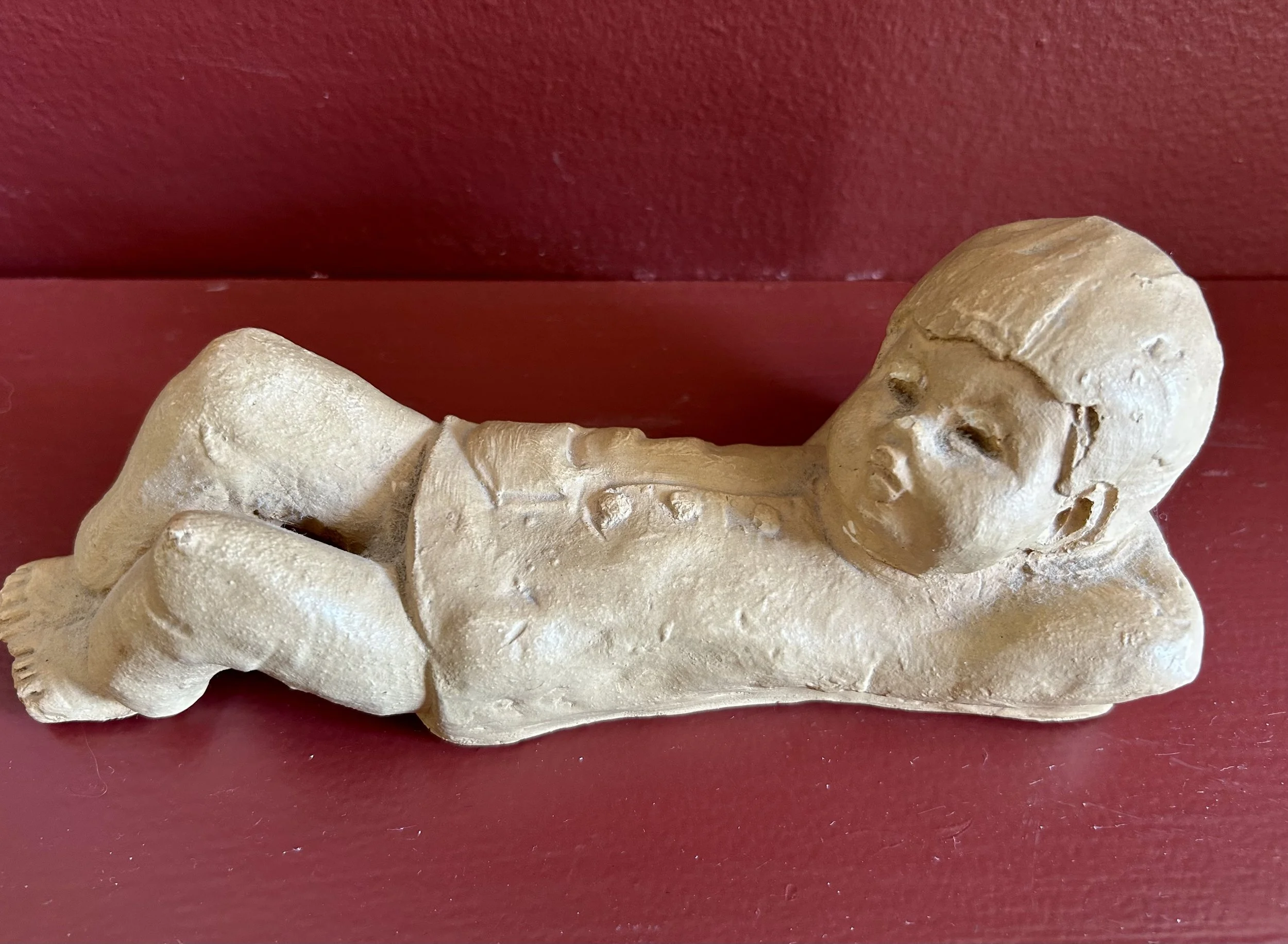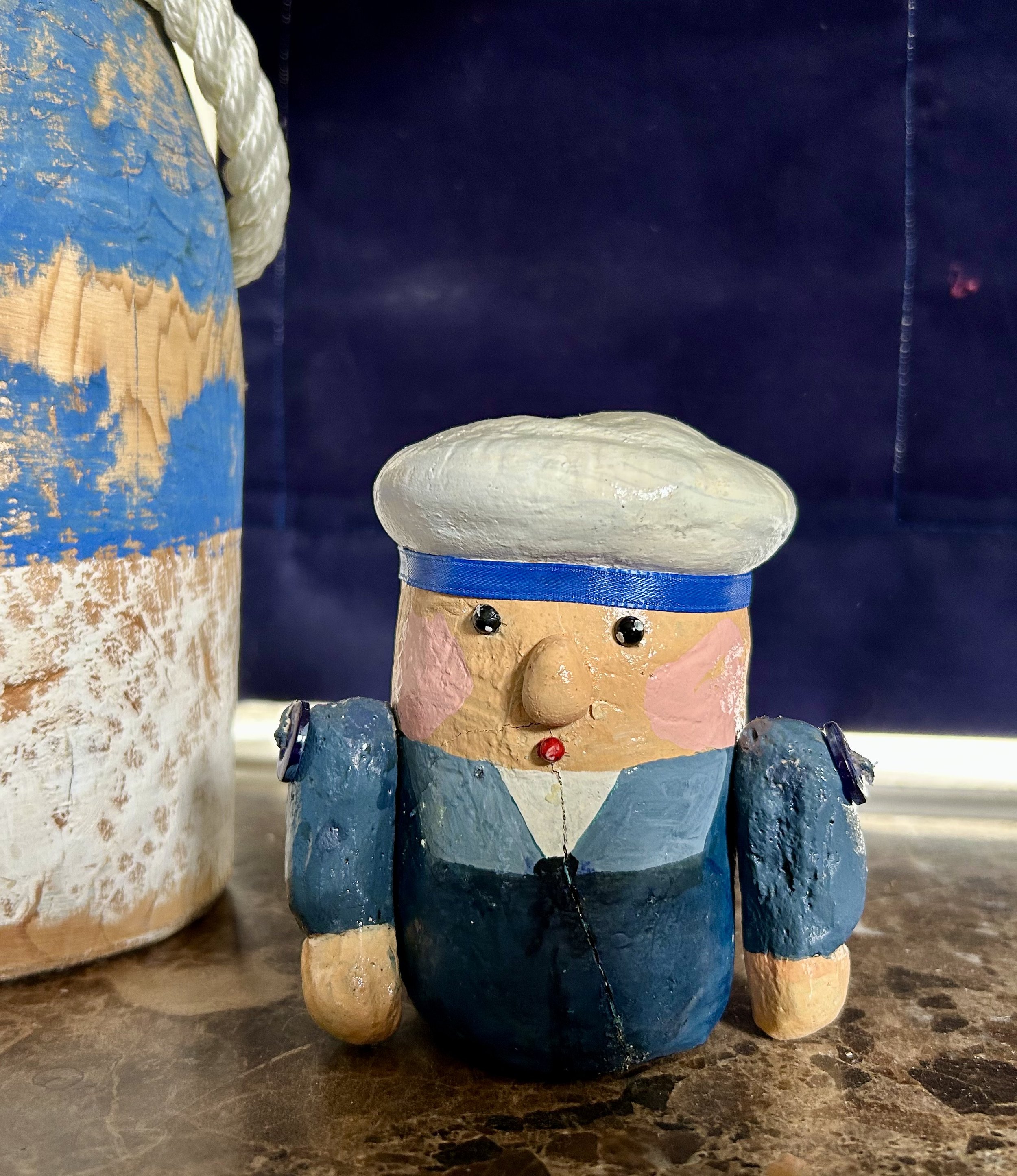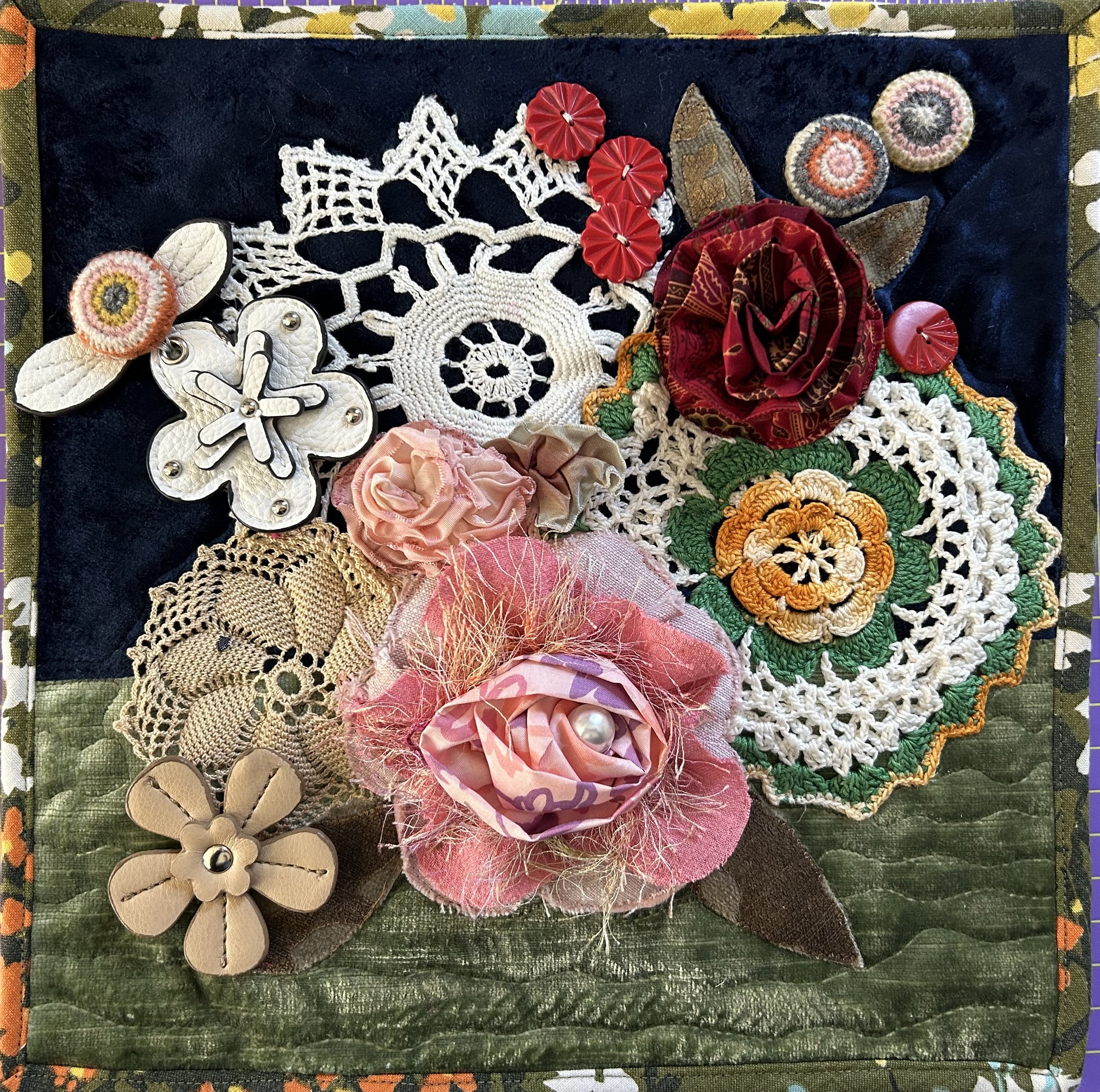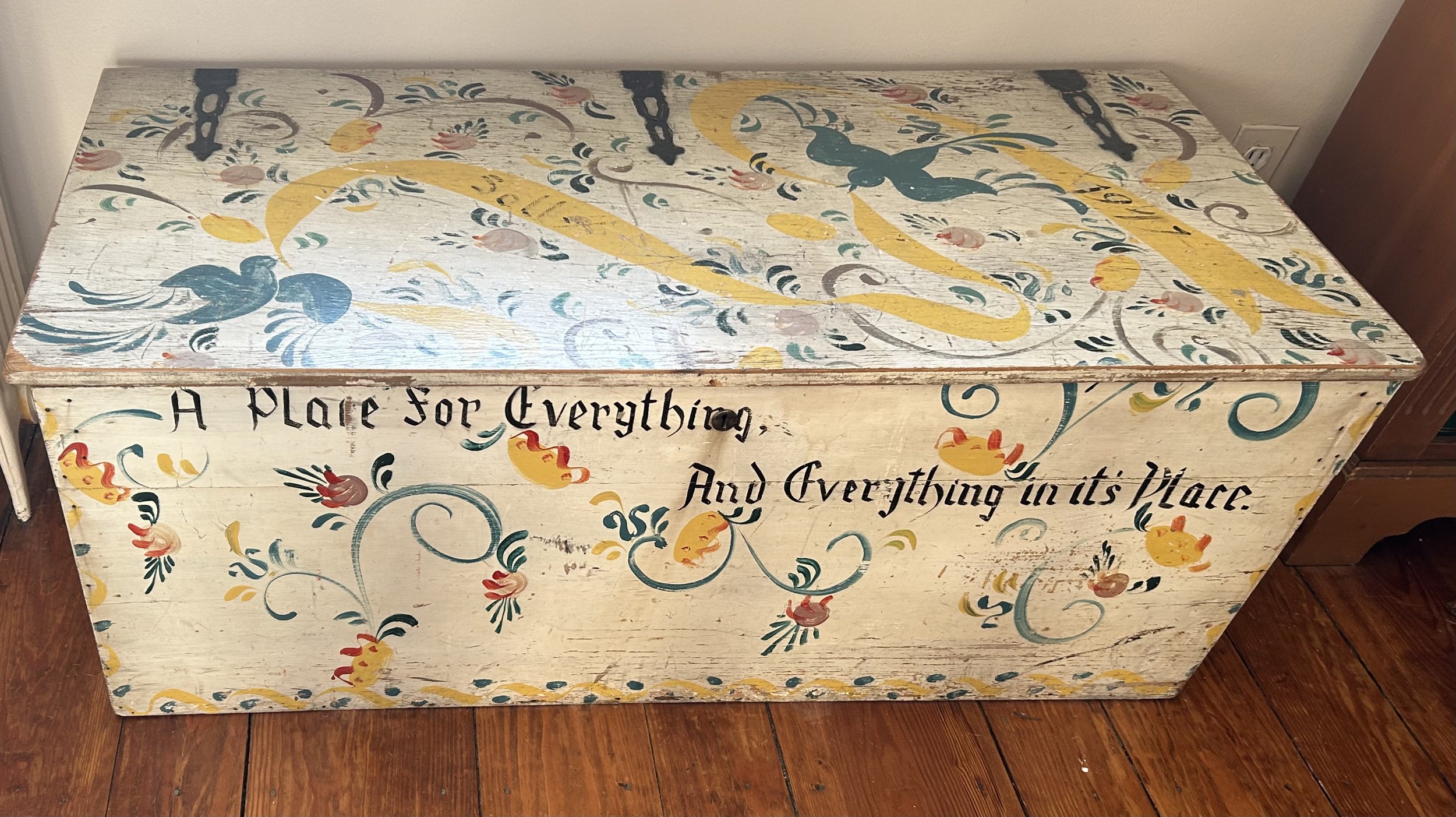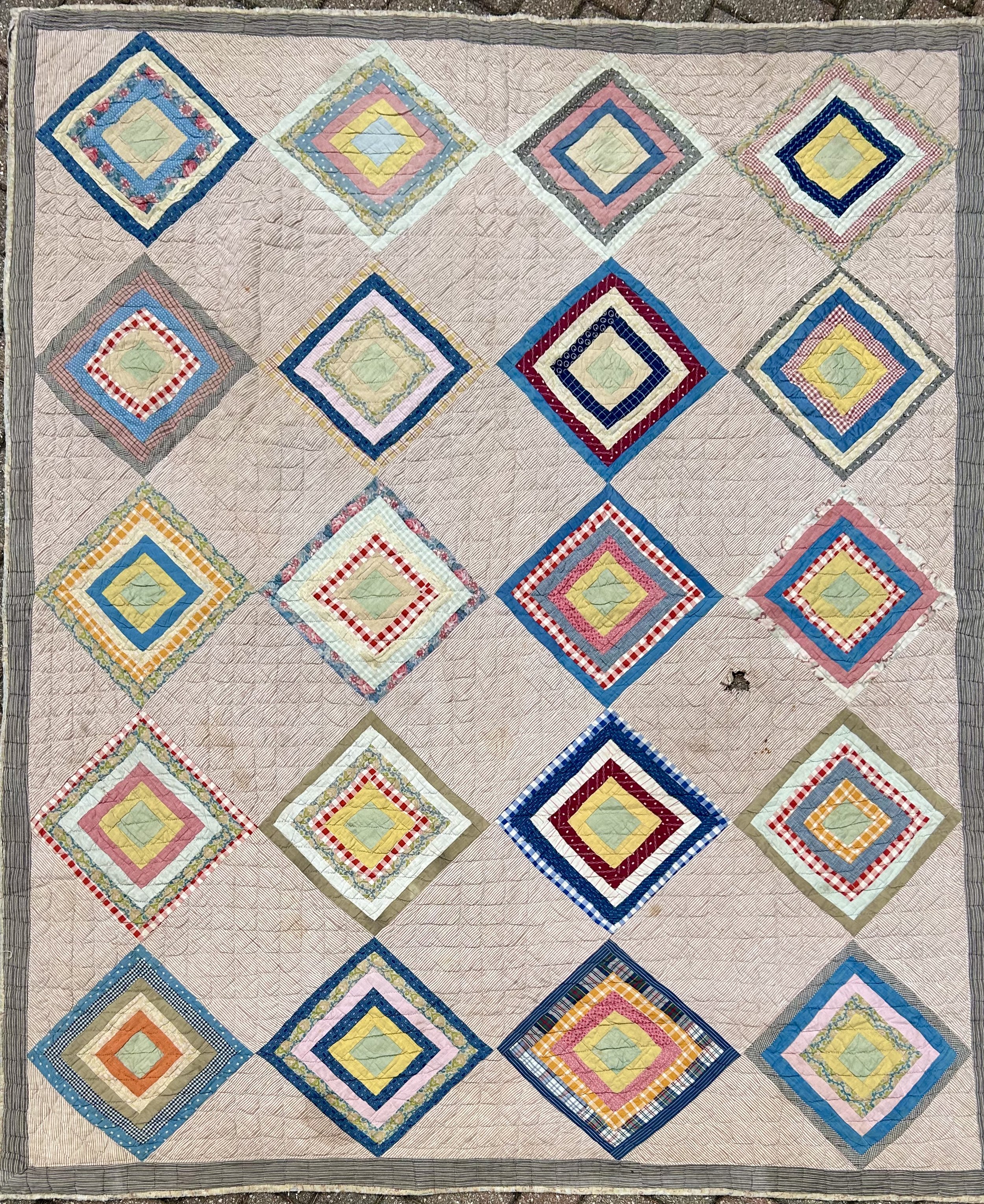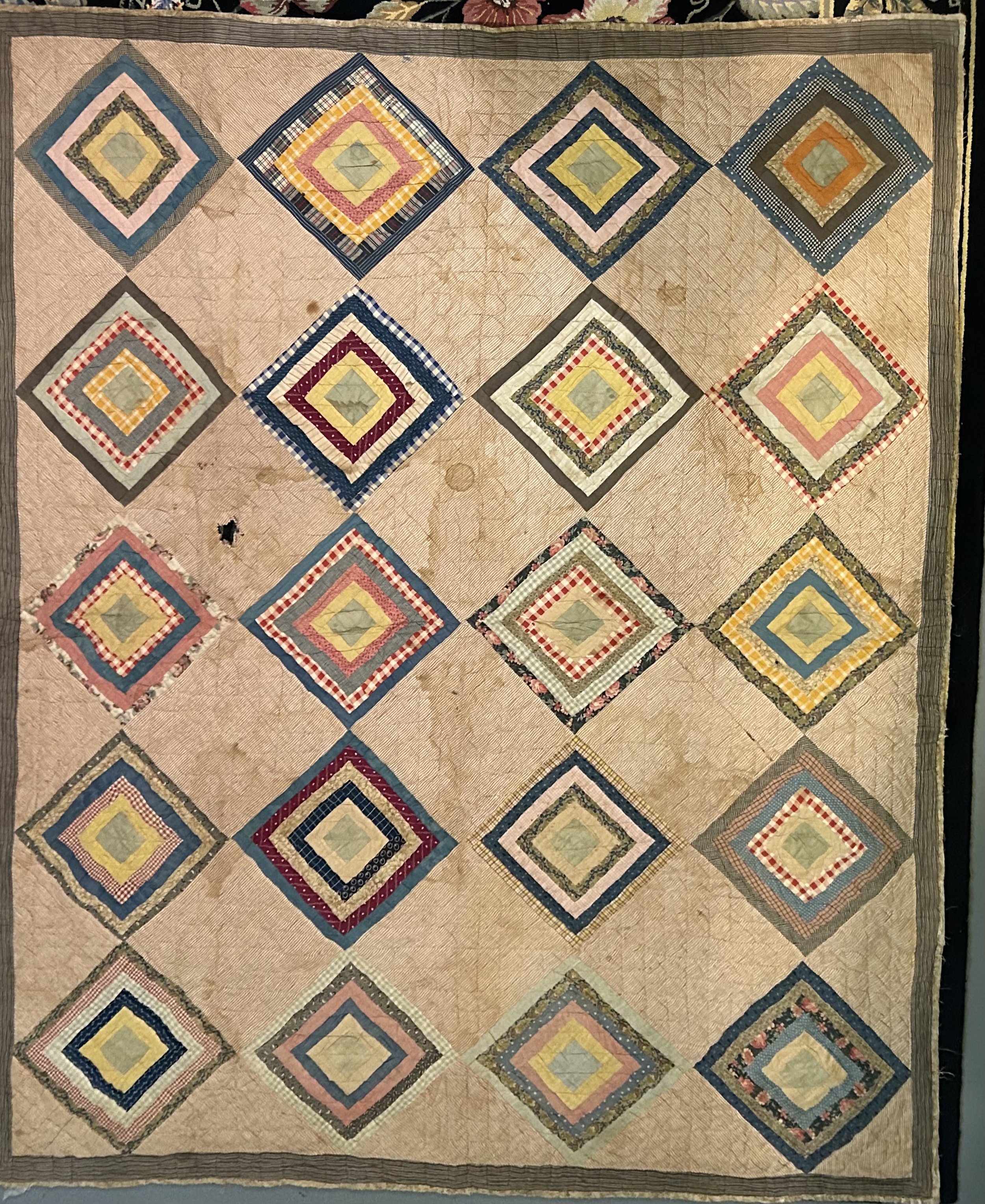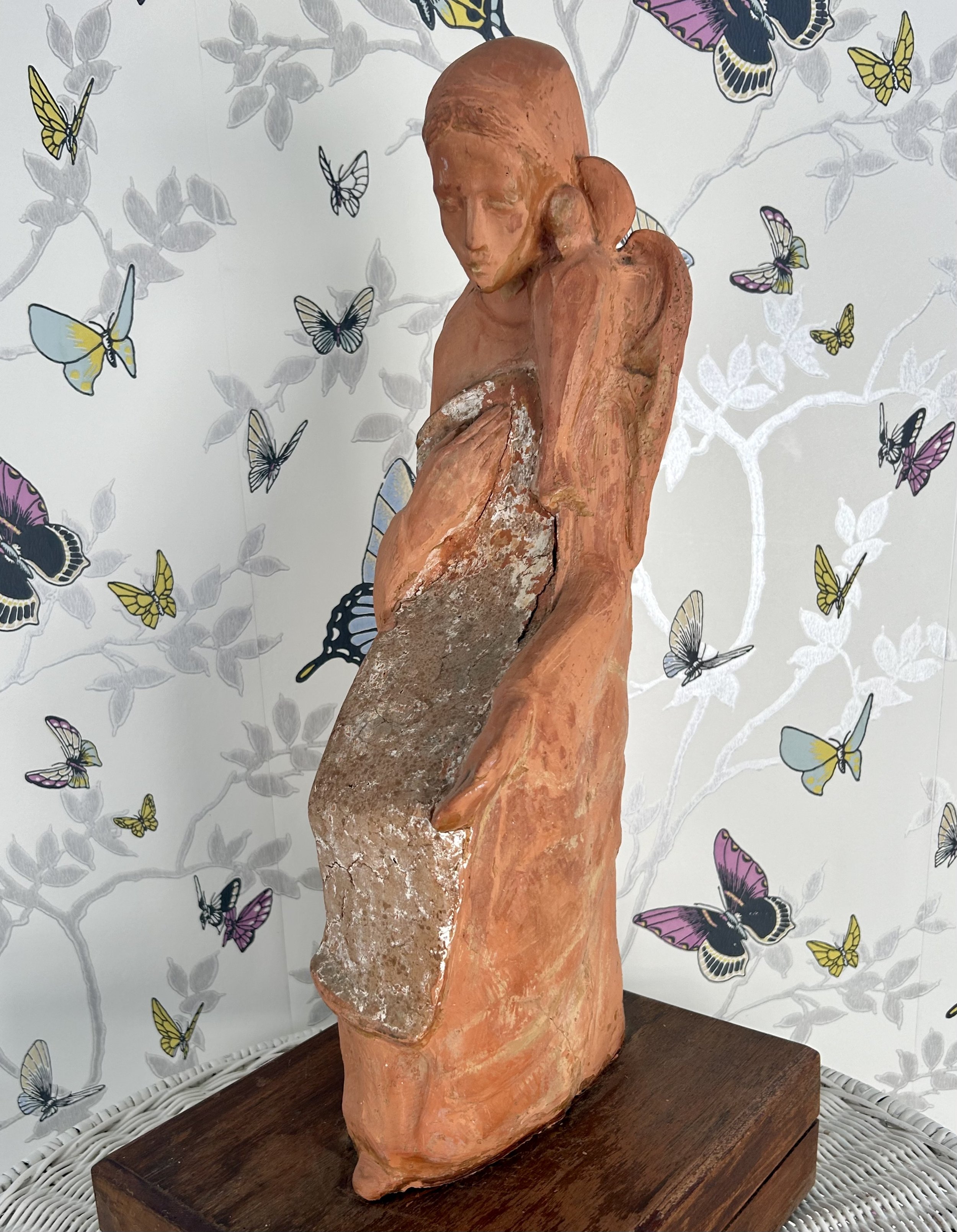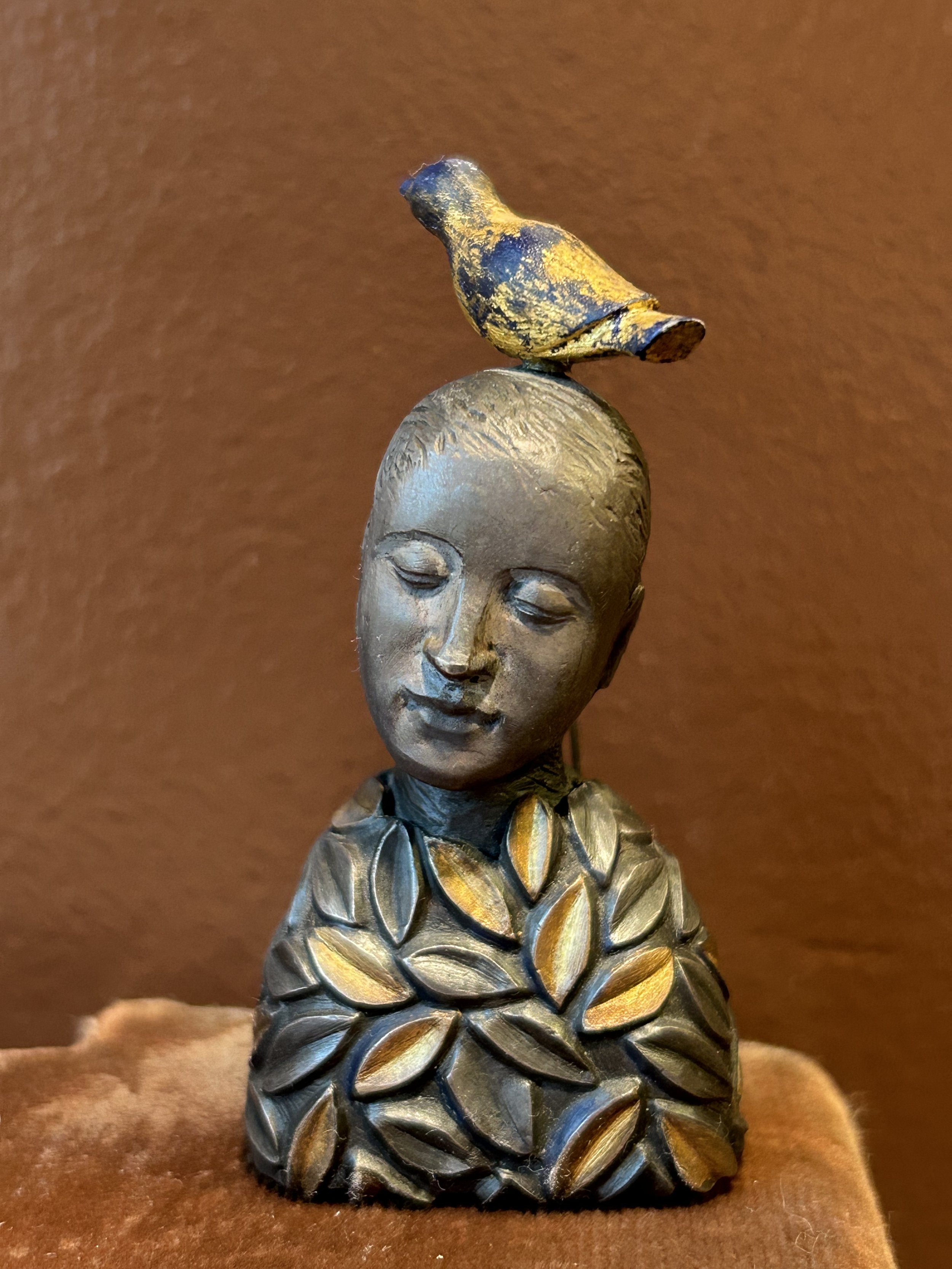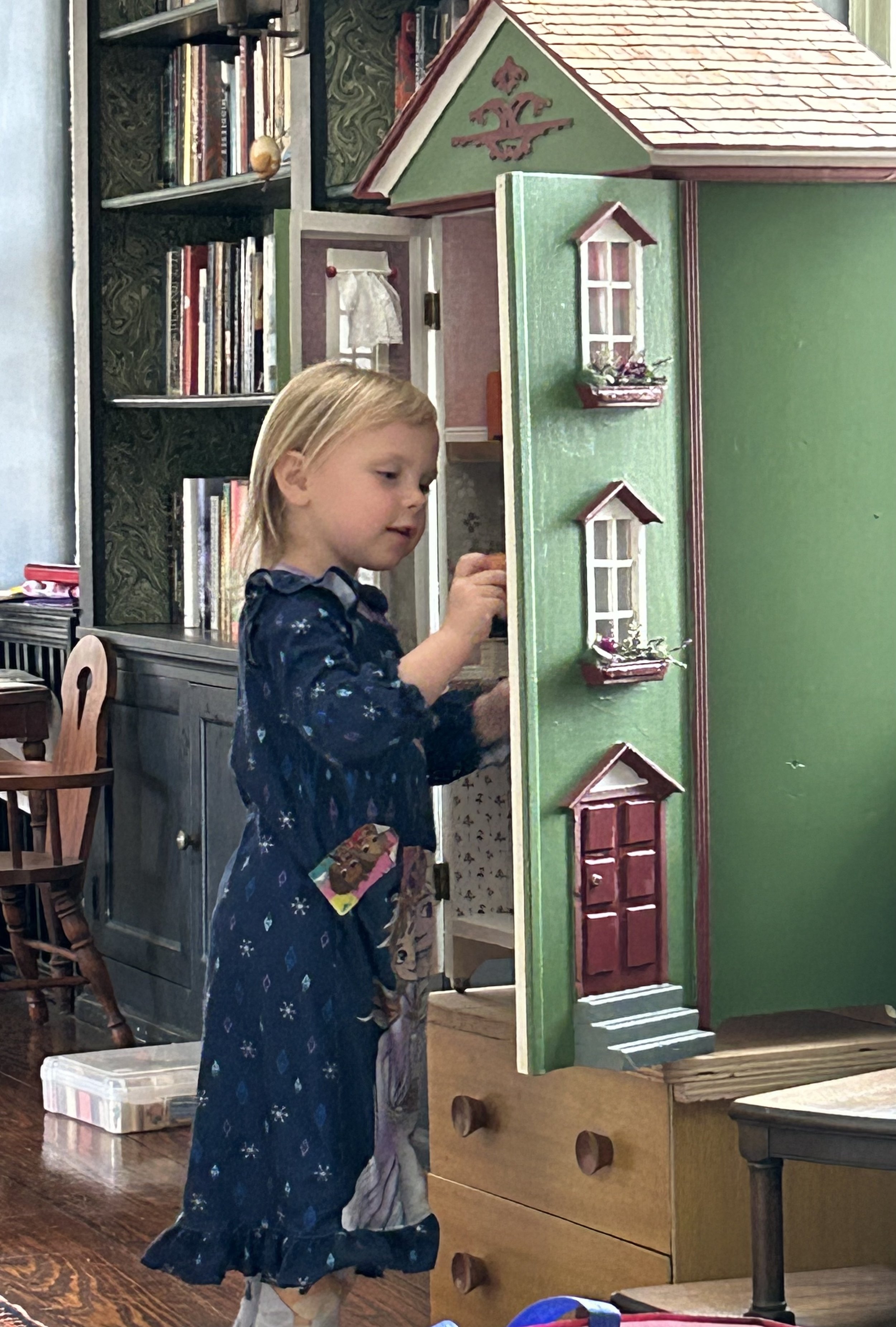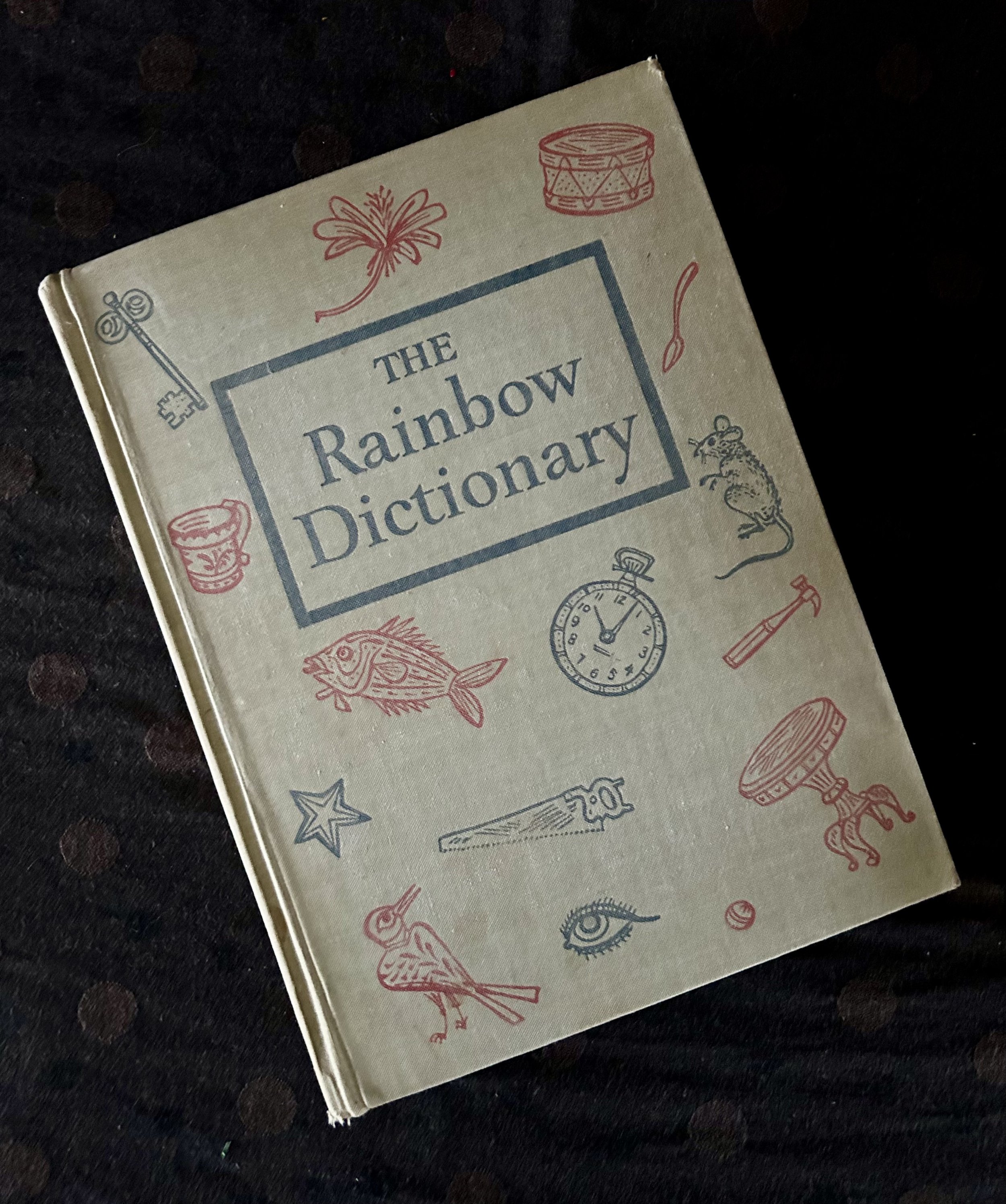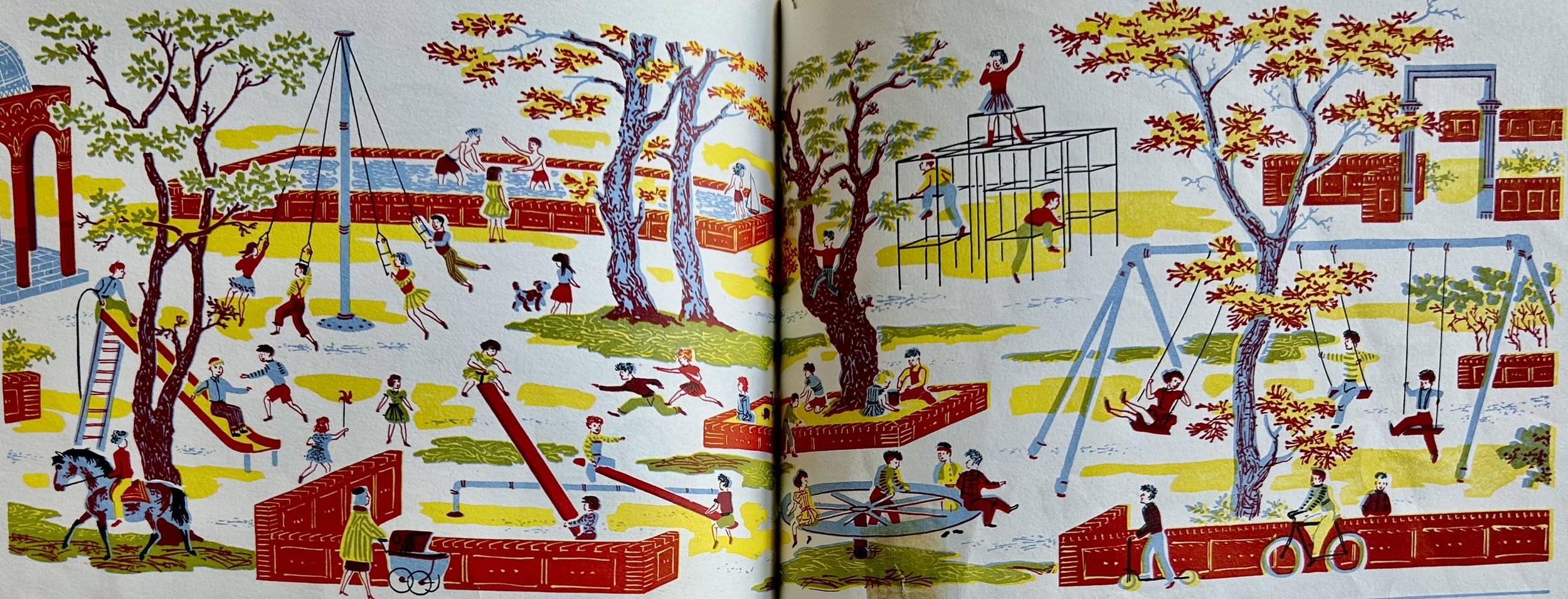A Rose By Any Other Name
It’s been a heck of a rocky road these past six months and my blogs have been few and far between. It started with a ridiculously expensive and lengthy crisis with our water service. While husband had shoulder surgery, with the correspondingly painful, difficult and lengthy recovery. Add a few personally upsetting issues, with corresponding sadnesses. Two emergency “help take care of the grandchildren for 4 days” outings. With lots of drives to Indy. And now a broken rib. So I am now exhausted. I am taking a few deep breaths, and trying to slow down and heal. Taking time to be creative in my sewing room, enjoying transforming found treasures (silk flower quilt and hand stitched wool needlepoint),and trying new ideas inspired by thrifted finds. But boy have I found some amazing artwork and I’m itching to get back to writing. Where does all the time go?! I’ll be back soon.
Humphrey All
Sometimes when we reflect on childhood memories, the feeling is one of a dream sequence. It becomes hard to separate what actually happened – and when – with how our mind strings those early memories together. This remarkable little painting by Polly Nicholl prompted me to think about some very early memories, and the summertime games my older siblings would play while I was “in bed” in the early 1960s.
The truth is, I was not “in bed” – I have distinct memories of climbing out of my crib to go stand by the window and watch my 5 siblings run around the yard in the summer dusk. I suspect I was around 2, living in the house my parents built on Barren Circle in Chappaqua, NY. My brothers and sisters would have been 10, 9, 7, 5 and four, and they played a game we called “Humphrey All”. The actual game is “Home Free All” – a version of tag where anyone who is “caught” can be freed by a player reaching the home base and yelling “home free all”. In my family’s case, we yelled “Humphrey All”. For obvious reasons but to be clear, my family name was Humphrey.
Our home was on a dead end circle, and there were only a few houses built at the time. Our house backed up to a very large “rock”, making no backyard but plenty of side yard and lots of front yard including the empty paved circle. On the other side of that “rock” was a marshy area with a small lake, though not accessible to our home, nor was I actually aware of it at the time. What I do recall are large turtles in the yard, merged into the evening games in my memory. I have no idea if this actually happened, but in all likelihood the turtles were being disturbed from their habitat as houses were being built, and they began to wander. These were not “pick up and look at” turtles – more “small boulder” sized. Why I recall them is unclear, but my memory has connected them to the evening games I watched from my bedroom window.
This image prompted these memories as we also had an old fashioned slide and metal swing set in our yard, and many an afternoon was spent playing on them. As the youngest of 4 girls, I was often watched over by my older sisters, and this image made me think of the 4 of us. Highly unlikely I was wearing a dress – or a red ribbon in my hair – but the ages of the girls is so much like the 4 of us that it seemed it depicted us.
The work was done in 1971, or at least framed in California at that time. Polly Nicoll was German, moving to this country “prior to WWII” the note on the back says. I was not able to find anything online about her, and am grateful for the note as it tells me she attended USC, studied writing, and then turned to art. Her note continues:
“Her main interest is the figure, though she finds some aspects of nature equally expressive in terms of form and space. She tends to search for the permanent rather than the transient and paints in a variety of styles because she feels ‘Monday’s works is not Friday’s, yet both are valid.’”
The work is a painting, and is very clever. Nicoll used the golden matt, also used in the framing, and inked over it to sketch out the image. The bows in the girls’ hair are added with dots of paint. Her style is very midcentury modern, and is remarkably expressive for such minimal use of paint. Somehow, with only a few lines, we can sense the swings moving, the girls eyeing their little sister, and the young red bowed girl sitting smugly on her swing. Today is Monday, I am rather busy these days doing all sorts of things, but come Friday, I am sure I will again turn to introspective moments as I enjoy lovely vintage artwork.
School Colors
I finished this quilt last week, after working on it for at least ten years, but likely longer. I first saw quilts done in the pattern at a quilt show in the early 2000s. A group of women had each made a quilt using Civil War reproduction fabrics in browns and pinks as specified by the pattern designer (“Ancient Stars” by Susan Garman, 2001). The displayed quilts were stunning, and I was drawn to the pattern. I have an affinity for antique quilts and entertained the idea of making one. The thought was not one I pursued, until years later the quilt pattern was donated to our guild garage sale, and I managed to snag it. Thus began a very long journey, complete with missteps, frustrations, and quandaries.
The first choice to make was the color pallet. I honestly don’t know why I chose modern pinks, nor why I picked gray instead of brown. As this was well over 10 years ago, it was not because gray was the current “in” color in decorating. In all likelihood I happened to have some pieces that complimented pink fabrics I had on hand, and thus I started the years-long journey with pink and gray, picking up more fabrics as needed. There were years the project was put away and left to gather dust. And I recall one phase where I thought about starting over as I really love pink and brown and what the heck was I thinking??
Back in the 1980s when “color theory” was the rage, my mother and I had our “colors done”. She was a Winter and I was a Fall. For a number of years she made me beige clothing as it was “my” color. Dear lord do I look half dead in beige. It may be my color but it doesn’t do a thing for me - I blend away into nothing. Even my husband banned me from the color, and my friends have long known to steer me away from beige clothing when we’re out shopping. Brown, however, looks great with my coloring. And since black is remarkably unflattering to me (being a “Fall”), brown has always been my go-to neutral. I honestly do not own a piece of black clothing, while my mother, with her Winter coloring, lived in black and jewel tones.
Brown is considered a “warm” color, and falls on the color wheel as a very dark version of orange. It is the earliest known color used by humans to create art, using variations of earth pigments to draw on caves. The word “brown” shows up in English language as early as the year 1000. Brown, like most colors, has both positive and negative associations. While the negative have to do with poverty, the positives are “a sense of strength and reliability, as well as feelings of warmth, comfort and security.” (https://www.dunnedwards.com/pros/blog/the-color-brown).
Pink has its own associations, almost all to do with romance, feminine attributes and kindness. Amusingly, when my daughter was young, her older brothers would announce “We’re in the pink zone” whenever we were shopping for girl clothing or toys! Pink lands in the red section of the color wheel, and thus pink and brown are neighbors – being offspring of Red and Orange. This is known as “analogous” colors, and is considered a calming or harmonious color combination. Interestingly, when you add white to blue or green, you refer to the color as “light blue” or “light green”. When you add white to red, you call it “pink”, a term that cropped up in usage back in 17th century Renaissance Italy. Many folks know I love the color pink, and I often wear pink and brown. And have a brown car (though sadly without a pink interior). So here I am, a pink and brown girl, grumbling about my pink and gray quilt, and considering bagging the whole darn thing after having made a significant number of pieces.
Then the Covid lockdown hit, and boy was I happy to have a huge project to tackle. I began cranking through the center blocks, and making the one inch “½ square triangles” of the inner borders. For those of you not quilt oriented, the 96 center blocks are an ‘Ohio star’ pattern. It is composed of a 9 patch, meaning blocks in a 3 x 3 square. To create the star shape some of the blocks are divided into a “ ½ square triangle”. This involves diagonals and fractions (yuck, who likes fractions?!) so the easiest option is to make oversized blocks and trim down to the correct size. No fractions! But tedious. Same with all those one inch “½ square triangle” blocks running around borders, all 452 of them.
As is the case with many quilt blocks, the parts of an Ohio Star can be put together in various ways by spinning those triangles. Some variations result in an “Ohio Star” pattern, and others are completely different. When I finished the 96 blocks and began putting them up on my design wall, I realized a number needed to be redone. I cannot recall how many, but enough to cause swearing and grumbling. Clearly I went a little wild during Covid lockdown. Or at least as wild as a quilter can go. Sigh. Which is all well and good and rather creative, but made for a substantial amount of nausea when the blocks started going together. I have no issue with nausea if that is the artist’s intention, but in this case there was too much going on to add wonky blocks that didn’t “look” like Ohio Stars.
Redoing the blocks did not mean simply reusing the parts already made. Some had to be redone entirely which made me rather grumpy. On top of already being grumpy that I was not making the damn thing in pink and brown. Which would look lovely in our bedroom with our antique brass bed and butternut furniture, Mom’s pink Turkish rug, and our chocolate brown dressing room. But no, I was making a pink and gray quilt. So it got put away. Again.
At some point, having an ‘unfinished project’ gets on my nerves, and I make a “do or die” decision. If I love the piece, I have to finish it. Otherwise I pass it on in some way. So about 2 years ago I decided I needed to finish the damn thing. (While I do swear a lot in general, this quilt really rose my swearing language to a new level.) In an effort to embrace the gray, I began to think about the colors and where they surfaced in my memory. My alma mater, Vassar College, has a stunning stain glass window in the 1905 library. It is known as the Cornaro Window and depicts Elena Lucrezia Cornaro Piscopia (1646-84), the first woman in history to receive a doctorate, defending her thesis in Padua in 1678. She is wearing pink robes thank you very much. The original school colors, pink and gray, were chosen in 1867, representing the rose of sunrise breaking through the gray of women’s previous intellectual life. Elena with her pink robes stands as a stunning symbol of women’s right to learning. https://vassarcampushistory.vassarspaces.net/architecture/the-cornaro-window/.
While the colors were changed at some point to be maroon and white, those of us old enough still think of Vassar as pink and gray, with its remarkable focus on educating women. While my quilt may be done – in pink and gray – I wonder how history will look back on women, and their education, during this journey we are all currently on. Time will tell, as it often does. Elena – my granddaughter’s name!- will stand proud in her pink robes as we close in on 400 years of our journey, complete with missteps, frustrations, and quandaries.
The Passage of Time
It sometimes amazes me how quickly life can pass us by. When children are little, parents feel like the days are endlessly long, especially when things are stressful and chaotic, with hardly enough time to sleep. But, soon enough, children are grown, parents are empty nesters, and the days seem to fly by. How the heck do I, a woman who basically doesn’t have a full time job, seem to have days filled with so much I never have time to accomplish all I want to do?! Those books piling up that I absolutely want to read? Dusty. The house projects I want to get done? Awaiting hubby’s involvement…which means very low on the ‘to do’ list. The quilt projects in my mind, and sometimes actually in bins in my sewing room? Great ideas, excited to get to them, but when the heck will that happen between the projects I need to do, the gifts I need to make, the found treasures needing repair or finishing?! I say all this as I look at this remarkable quilt, realizing it is a perfect example of time passing.
I found it during a Bins thrifting outing a few weeks back. The work was originally done as a table cloth, beautifully cross stitched in red on a heavy linen ground. The women was a talented needlewoman as the back is nearly as lovely as the front. I would guess it was done in the 1950s, a time when sitting by a television in the evening or listening to radio broadcasts was the family entertainment. I am unclear if it was a “stamped” pattern or if the woman designed it herself. Given the era, I suspect it was a printed pattern, but either way the time needed to complete the piece was significant. A family held onto it, likely unused as it was always considered a “special” piece. We hold onto those “special” items, handmade by someone we love, as we don’t want to damage them. But what is their value if no one remembers using them? I always insist to new parents that my gifted quilts should be used, thrown on the floor, dragged around in a stroller, snuggled under while reading a book. Otherwise, it languishes as a “pretty” thing no one has a relationship to. Children grow up, parents downsize, and suddenly that “special” quilt -or table cloth – is sent off to a thrift store as no one really cares about it.
When I found this remarkable red work tablecloth, unused and then discarded, I thought it would make a lovely quilt. That said, there was not a chance in hell I would have time to hand quilt the piece – a process that is charming but so darn time consuming almost no quilter I know does so anymore. I could quilt it on my domestic sewing machine, but my skill doing so is rudimentary, and would not do the piece any justice. A dear friend who is a remarkably talented quilter offered to do the work for me on her long arm quilting machine. She did NOT have to ask me twice! How the heck she came up with the beautiful design and executed it so stunningly is beyond me. So now I feel rather guilty.
Not only did she finish the piece a few weeks ago – and I have not as yet had time to write about it – I am not sure how to repay her generosity. She requested I take her and a granddaughter to a Bins outing which hardly seems like work to me! But being a tour guide to the Bins is an amusing process as it is truly a unique world, filled with characters and rules and all sorts of divergent dynamics: people shopping for specific items, selling “found’ treasures to peers, discussing resale values and experiences, dealing with children and teens, watching “on- line sales” events live in the store. And finding treasures.
I also feel guilty submitting the quilt in my local quilt guild’s upcoming October show. The irony is that I basically invested no time into the piece, even though I am submitting it as “my” quilt! The unknown woman who did the red cross stitch work? The lovely friend who designed and quilted the work to bring it to life? Or me, who basically put on the binding? Yup, I win!
The Sun and The Moon
These two quilt tops are projects I have been creating for a client. She had lost her husband a few years ago and struggled to part with his clothing in her grief.
These two quilt tops are projects I have been creating for a client. She had lost her husband a few years ago and struggled to part with his clothing in her grief. Eventually she contacted me and requested I make some quilts using his shirts. The first set, made a year or so ago, was designed for a daughter’s young twins, and had a dot theme. She then requested a pair of quilts for another daughter. As any parent knows, you can’t gift one child something special without considering the other sibling! The idea was to have an image of a beach sunset due to the family’s love of Key West.
Figuring out a way to utilize only men’s shirts into a beach sunset image was a bit of a challenge. Eventually I found a pattern designed by Karen S. Biglik of Fabric Addict called “Sunset at Sea” (https://www.fabricaddict.net/). The pattern uses 16 different fabrics and is rather complex, not from the sewing perspective but due to the design requirements. The construction requires each fabric to be used in specific places, thus creating the visual of the sun’s reflection in the water. To accomplish this with the shirts, I had to adjust the pattern’s key to reflect my fabric choices. And then the anxiety set in.
The quilt directions specified how much of each fabric was needed IN YARDAGE…and I had shirts. I was leery of not having enough fabric since I was using the husband’s shirts and clearly couldn’t dash to a store to get more. What to do if I ran out? How to figure out if I would have enough? I purchased a shirt from a thrift shop and chopped it up to see how much I could expect to get. Turns out, you can actually cut a lot of useful pieces from a shirt. However, the pattern direction specified cutting yardage into strips and sub cutting those to get the pieces needed. I didn’t have that luxury so I had to calculate each fabric’s specific size pieces and cut individually. Sigh.
Construction involved a great deal of zip lock baggies with labels, piles of units and a lot of swearing. Once done with the Sunset top, I discovered an error – I was rather surprised there was only one! The photo above still has the error in it though I have fixed it in the meantime. The client loved the work and I was left mulling what to do about a second quilt. Some of the shirts would not produce enough fabric to create the same top again, and, to be honest, I really didn’t want to make two nearly identical quilts. Boring. After a bit of thought, I asked her if she might like the second quilt to be a moon rise. She loved the idea. Having already worked through the challenges, the moon was a tad easier except for the coloring.
My color palette for the moon was cool colors – blues, grays and whites of which there were oodles of shirts. I wanted the sky to seem like a gray evening but when I began creating the image, it was rather dull. I pieced the ocean sections together but left the sky in strips on my design wall to assess. The most obvious solution was to create “stars” in the night sky. To do so I had to disassemble some blocks, make tiny half square triangles of the corresponding background color with yellow, and then piece them back together. Another sigh.
I think the resulting quilts work well and, once quilted, the client is excited to share them with her daughter. While they could be considered a “baby quilt” in size, I think of them more as wall art, proclaiming to a beloved that “you are my sunshine” and “I love you to the moon and back”.
Worth More Than Money
A local designer has hosted estate sales over the last year or so, and I twitch with anticipation when one is coming up. At the recent one, Hubby and I had fun gawking at vintage art, furniture and treasures, admiring many cool items. Most were way beyond our budget, so while I covet fabulous pieces, I have to contend myself with not so expensive treasures. When we first arrived at the sale, I saw this small statute and immediately picked her up. Not cheap by thrift store standards, but no matter: she was coming home with us.
She is not marked in any fashion, and the seller told me she was Deco and made of plaster. I guessed the era but was not familiar with plaster as a sculpture medium. Off to the internet. Turns out, Plaster of Paris has been used by artists for thousands of years. It is much like modeling clay, so the resulting piece is either directly molded by the artist’s hands or casted from a mold of an original design. It was used to build the pyramids of Egypt as well as Pompeii’s walls. For centuries, an area near Paris contained the needed gypsum to create the clay. In 1254 King Henry III visited Paris, was so impressed with the French’s fine white (plaster) walls, that he introduced the stuff to England where it became known as “Plaster of Paris”. Its use for actual artwork started in 16th century Italy.
During the estate sale, as my arms got full of finds, the staff carted the pieces to a table near the checkout area, one of many piles for fellow shoppers hunting for treasures. At one point hubby had a few things to add, and he carried his finds to the pile table. When he returned, I wondered if he found my pile, mentioning mine included a white female sculpture. Yeah, he says, I figured that was your pile. Made me laugh.
Clearly hubby recognizes I tend to pick up artwork with a female focus. When I brought my Deco girl home, I wandered around the house counting the female sculpture works scattered about: twenty three at the moment. I have written about many of them (15 plus a few more I have sold), and this doesn’t include paintings with feminine figures. For amusement sake, I then counted the male statuary – that didn’t take long! There are 5, three of which I have written about. One belonged to my mother-in-law, Lottie Jarrett (1926 - 1988).
This figure of a boy was one of three similar works Lottie owned. My husband’s father requested my two sisters-in-law and I each select a statues after Lottie had died. I don’t recall what the other 2 looked like, but in 1988 everyone said this statue represented my dreamer husband. As a newlywed, I found it a sweet thought, though the work isn’t something I would like normally (too “precious moments” for my taste). I am not clear if hubby is sentimental about it, but I have so few items from Lottie, that I have kept him. My counting exercise made me curious about the piece, and started research.
The artist, Ann Entis, worked at Dave Grossman Designs Inc of St. Louis in the late 1960s and 1970s. Her works are all similar child-like statues done in a tan clay. There are many of them lurking about in thrift stores as they were cast from molds and produced in volume. In my research I came across a fascinating law suit filed by Mr. Grossman in 1972 against an Illinois manufacturer for copying the works designed by Ms. Entis. The entire case notes are available on line, and it seems the case was decided in Grossman’s favor (https://law.justia.com/cases). Apparently the court agreed Ann Entis’ sculpted child faces and styling were copyright protected.
If you image search the Ann Entis figurine, thousands of images pop up, including many similar ones by a woman named Lee Bortin of Chicago. Turns out, she was the defendant who lost in the 1972 court case to Dave Grossman Designs! That said, neither Bortin’s figures nor Entis’ are particularly valuable, well under $20 these days. The Entis figurines were sold locally in St. Louis by Grossman Inc, which operated from the 1960s until 1981. As my in-laws lived in St. Louis from 1979 to 1982, I suspect Lottie picked up the 3 figurines at that time, choosing three boys to represent her three sons. She died 6 years later.
If you do an image search of my Deco female, not a single image shows up that looks even vaguely similar. I suspect she is a one of a kind piece, hand sculpted by someone in the 1920s, though her value is unclear. Unsigned and with no distinctive details, she is only as valuable as my enjoyment of her. My mother-in-law’s inexpensive, mass produced dreaming boy realistically has even less financial value. The female figurines gracing our home I find lovely but I am eh regarding the little boy. Maybe because it is male, but likely more to do with the mass production aspect. But the little boy has personal history and a connection to my husband’s parents – something that is worth more than money.
Off With Her Head
This work, titled “The Ace and Queen of Spades 1st Stage”, is a lithograph by Pat Snyder, dated 1967. When I came across it at a church rummage sale, I thought it was related to Alice in Wonderland, and purchased it without much thought, tucking it away in my art closet. The work is masterfully done, but there is a slightly disturbing vibe to the piece, and I chalked that up to the Queen of Hearts from Alice In Wonderland. As I had not done any significant viewing of the piece, I pulled it out the other day to study it more closely. Definitely not Alice, though the small guillotine in the image screams “off with her head”.
The work draws your eye – literally – to the central junction of the cards. Hidden there, amid the wood grain of the floor boards, is a slithering tail of a snake, peeking out between the cards. Notice the “central” point is actually off center to the left– a masterful stroke by the artist to make us nervous. The term being “off center” describe feelings of instability, or a sense of nervousness of things being “off”. To make sure we don’t miss the point, the snake then reemerges inside the frame of the Ace of Spades card – winding its way up a tree, head pointing us in the right direction. This, too, is a quirk of human nature: we tend to go right when faced with choices. We enter a shop and turn to the right. We (mostly) read to the right. We scan newspapers to the right (okay, sure, I’m dating myself). But the reality remains that we tend to head right – though maybe not in moral issues. And, in case anyone wonders, the Ace of Spades is the highest card in a deck and is known for its association with power, authority and dominance.
As we look over the Ace of Spades, drawn in by our friendly serpent, the storm clouds overhead swirl with a Dante Infero-esque cloud of bodies. A sense of souls piling up in hell. Not to belabor the point, but those are all women, and they sprout from the head of the small, naked – female – figure fleeing in the foreground. And yet our buddy Adam is fully clothed and not easily identifiable other than guilt by association. Mr. Snyder then whacks us over the head with Adam covering his eyes and wearing a religious symbol. Well then. Things are getting curiouser and curiouser.
Mr. Snyder actually created a self-portrait in the work, which is how I determining Pat is male. I would have guessed the artist was a woman due to the era – late 1960s with all its women’s rights demands – and the emerging theme. However, the artist stands in the foreground, depicting history from his perspective as he looks over his left shoulder (not right!) at his subject. He wears glasses, and holds a pallet in the shape of a spade. Traditionally, the Jack of Spades was considered a messenger, a person in a capacity of trust. Sometimes “this card is used to designate a critic, or a critical position; a moment of impending danger.” (https://cardarium.com/jack-of-spades). The “reverse” of the card – meaning the upside down side – signifies scrutiny or inquirer.
I bring this up because the undercurrents of the work begin to congeal around issues of women and the degree to which they are blamed and judged. We have already introduced Eve, and there are 2 queen of spade cards. One holds up the left side of the house of cards. The other smaller one is situated on an easel. The queen in the smaller card holds a playing card and a baby, and the easel upon which she rests is actually a guillotine. The baby is very faint, still seeming to be in-utero, and the playing card is the Ace of Spades, signed by the artist. I get the sense Mr. Snyder is sympathetic to the plight of women, with them carrying all the blame and damage, specifically around the issue of abortion, while the man literally runs away with his eyes covered. Though that may simply be my feeling reading into the work.
And then we have our king. The floor “king” has no “house” though he wears a Star of David, has stigmata in his hands and feet, and appears to act as the “rug” in our house of cards, upon which we all tread. Mr. Snyder is not subtle, I give him that.
Tin Can Art
When I was in elementary school in Darien Connecticut, my favorite classes were Gym and Art. I was an extreme tomboy with such short hair, I was often called a little boy. Many times when “sides” were chosen – yup, gym teacher would assign two captains to pick students for teams – I would be one of the first picked. I was scrappy, tough and very fast. How times have changed! Not scrappy. Not very fast, and definitely not short hair. What hasn’t changed is my love of art.
The art teacher was a funky young woman who created all sorts of fun projects. As this was 1976, one group project was sewing red, white and blue quilt squares into a large quilt for a fundraiser for the school. I managed to sew my block right onto my pants, so my first foray into quilting certainly was not highly successful. Another project was using myriad supplies, scraps and junk the teacher collected, to build a sculpture. I built an Eskimo, using a large coffee can and fur fabric scraps. The art teacher liked it so much, she used it on the cover of a “catalogue” she created for the school-wide art show that Spring. I still regret it was long since thrown away –one of those things I wish I had kept as it was a charming “child” art project. I have kept many of my children’s projects, and some day they may appreciate having them. Or not – but at least they can decide.
When I saw this little guy at the thrift shop I had to bring him home. He reminded me of my missing Eskimo, and he is so clearly a child’s art project he makes me smile. Complete with the tin can body! Instead of using fabric for clothing, the child used papier-mâché, building up his body and hat in one go, and plunking a nose on his face. The swinging arms were added using a nail covered over with a button. The artist then painted the sailor, including his white scarf and pink cheeks. My favorite is the pins used for his eyes and mouth, and the snazzy blue ribbon hat brim. He has some sadnesses, including a crack down his front, but he fits right in my son’s childhood sailing theme bedroom, now a guest room.
Don’t give me a theme as my OCD nature means I hold onto them for ages, in this case over 25 years. While my son has moved to his own home, taking many of his childhood room’s items, I still find sailing themed treasures to add to the room. Thankfully he and his wife have created a sea theme bathroom with a kraken shower curtain, so some of my finds end up sailing to Colorado. My children are stuck with my memories of their childhood loves, and it is hard not to continue to give them packages full of treasures. As they are grown and married, I have to show some refrain, though any treasure that doesn’t speak to them is allowed to move on in the world. But, mind you, refrain is a comparative term. And my favorite adage? One man’s trash is another’s treasure. Thrift shops are amazing depositories that reflect this – and some of the items I come across, both art and quilts, astonish me. I understand holding onto all those family mementos isn’t always possible, but such a little guy as this? How could a mother part with him?!
Rorschach Test
While I sometimes find valuable treasures thrifting, other times I pick up something simply because it makes me smile. This object is a bit of a Rorschach Test – I know what the thing actually IS but I can’t get passed the funny pink face staring back at me. Not exactly clear what Hermann Rorschach (1884-1922) would make of this, but most of the folks at the thrift store gave me quizzical looks. Why in the world, they seemed to say, would I want to buy such a beat up, old, heavy item when things cost $1.62 per pound? I had it weighed – 5 pounds – and felt $8 was not a bad sum for such an amusing yard decoration.
The piece was made by the Perky Pet Company as a “squirrel-be-gone feeder” likely in the 1950s. The company, still in business in Denver, started in 1958 making humming bird feeders. This model was a bird feeder designed to stop those pesky squirrels from raiding the feed, as their weight would “shut the door” of the feeder. However, mine seems to have been transformed a tad. Someone sealed up the clear windows and door and added metal washers to resemble eyes. And then painted the whole thing pink. Not sure why, but I suspect the thing had stopped working and a creative soul decided to transform it into funny yard art.
God knows I do not need to feed the myriad of squirrels and chipmunks running rampant on my property. They help themselves to all sorts of things, including anything stored in the barn. Oddly, they enjoy eating through electrical cords so the lighting in the barn loft has to be arranged such that they can’t get to the plugs. The charming holiday lights strung in the rafters by my son in high school are long since non functioning as the squirrels ate most of the wiring.
Early in our ownership of the property, I stored furniture and items awaiting a renovated kitchen in the barn attic. Bad idea. The furniture was destroyed, either through nesting or nibbling, including my mother-in-law’s charming old maple sewing cabinet. A vintage wood high chair used by my baby daughter apparently had food remnants on the tray – boy did the squirrels enjoy gnawing that to splinters. I also stored a treasured vintage cookie jar, picked up years ago at an antique store in Evanston for $30 – a Helene Hutula “tattle tale” jar from the 1930s. When I went to look for it after our kitchen was remodeled, I couldn’t find the box anywhere. Puzzled, I dug deeper into the creepy attic, only to discover PIECES of the cookie jar scattered over the floor – the damn squirrels had shredded the entire cardboard box to use for nesting and the poor jar smashed to the floor.
Husband has often threatened to purchase a pellet gun and do in the squirrels that insist on sneaking into the barn, nesting and raising babies in comfort. And destroying things. Moth balls, dogs and patching holes doesn’t seem to stop them. As yet we’ve left them in peace and simply worked around them, out-smarting them when possible. And not storing anything shreddable. For now my pink “squirrel-be-gone” feeder sits at the backdoor, making me smile every time I see him. And I let my dog do all the squirrel chasing she likes.
A Grandmother’s (Thrifted) Flower Garden
Village Quilters Quilt Guild holds a quilt show every other year, with a show this year on October 24-25 at the College of Lake County. I bring this up to explain this little quilt, as it is for the upcoming show. One of the sections of my guild’s show is known as a “Quilt Challenge,” managed by a member who comes up with a creative theme. The finished quilt needs to be 12” square, and follow the guidelines given. This year the granddaughter-grandmother team running the challenge created the requirement of a quilt with a “3-D” element – meaning something pokes off the surface of the fabric. There are any number of ways to accomplish this, and if you attend the show you will likely see some remarkable ones.
Initially, I wasn’t particularly inspired. Nothing about origami quilt-making or dimensional applique was peaking my interest. On one of my thrift outings, I found a vintage lace doily with a yellow center that looked so much like a flower, I began to envision a collage quilt. As my brain began pinging about, I grew this imaginary garden with found items, including buttons, flowers, and lace. As with any garden, I needed to prepare the ground first, deciding in this case velvets would offer a tactile foundation. Off I went to locate some interesting clothing I could chop up. Modern fabrics – and the clothes made from them – tend to have a great deal of lycra in them which may make comfortable, stretchy clothing, but is not ideal for quilt projects. I needed to find vintage pieces, and luckily located some vintage green velvet and a 1980s child dress in dark blue velvet, with astonishingly awful lace around the collar. I’d dug up the foundation, now to plant the garden.
Digging around my sewing room, I uncovered a number of doilies and three dimensional flower pins. I don’t recall how I came to own the two larger ones, but they were perfect for my flowerbed. The small pink silk flower, however, was a Village Quilters Quilt Show award ribbon from 1995, and I sacrificed it to my garden. The leather flowers were purse doodads found while thrifting which I parted from their cheap (unloved) purses. They ended up causing a bit of annoyance as I had to fetch all sorts of tools to pry them apart from their keyring hooks. They had leaves as well, which I pried out of their irksome metal rings, and tacked down, but felt I needed more flowers sprinkled about.
Now is time for me to make a confession, all to introduce the fun crochet buttons in my flower garden, and likely the red buttons as well. My husband claims I am shameless - feeling the pilfering I am about to confess to is a bit of a questionable behavior. My side of the equation is that the thrifting Bins outlet is the final destination for myriad piles of clothing, and, if not sold, are heading out the door for recycling. Basically, while thrifting at the Bins, I keep teeny tiny scissors (pink naturally) in my pocket. When I come across clothing with fabulous buttons, I snip them off, much like taking a cutting of an unusual plant you find on a walk and want to plant in your garden. The snipped buttons are purchased by weight so realistically they cost pennies, but I am putting some part of the unloved clothing to use before it becomes landfill. Many times the item is already missing a button or two – it seems the vast majority of thrifting shoppers have no clue how to sew a button (or fix a seam, or patch a hole, or mend a hem). I will also confess that I often pick up amazing things because they are missing a button – which I can easily remedy. Given how expensive clothing – and crafting supplies – are, I don’t feel bad “reusing” old items or finding buried treasures I can repair to use or sell.
Once I had my garden designed, I used temporary glue and pins to hold the items in place. Basting the piece with a fun 1970s garden fabric remnant on the back, I was ready to tack everything in place. I used the quilting to adhere all the loose pieces of lace and the edges of the three dimensional flowers, though I did hand sew the buttons and leather pieces down. Such a fun project – both serendipitous for the fun it brought me making it, and the use of found treasures. As I am a grandmother, called Nana, I decided my ideal garden is one grown with fabric and thrifted treasures, not the one I should be tending to outside in my yard. Come to the show in October and decide for yourself which entry in the Quilt Challenge is the most successful.
A Place For Everything in 1947
I love things that are handmade or well designed –I cannot pass up treasures that speak to me, regardless of whether I need them or not. Sadly, some of the treasures have no place to reside, and over time, I decide to part with them. This trunk is not one of them. I picked it up at the local flea market 25 years ago. The piece was rough, the paint was chippy and it was dirty, but for $30 I carted it home. After a great deal of cleaning, sanding, and sealing, it has resided in the upstairs hallway ever since, a depository for childhood toys and laundry baskets making their way upstairs. The box is made of heavy plywood, charmingly painted to look fancy. It has “Sally” and “1947” written in the yellow ribbon, and proudly proclaims “A place for everything, and everything in its place”. “Sally” was either a very well organized child who made the trunk, or her mother who wished her daughter would clean up a bit more.
There are times when I struggle emotionally, when things are uncertain or upsetting, and I need to control my life somehow. For as long as I can remember, my go-to was to clean. Stressful situation? At least my closets are clean, my sewing room organized, my belongings parsed down to only those things that are important. My need to organize is deeply rooted in my need to understand emotions and shed unnecessary belongings – or distresses. There is something remarkably cathartic in schlepping bags of unneeded [fill in the blank] to a thrift store for someone else to take on. The more stressed, busy or upset I am, the more organizing and cleaning I do.
The moms of my childhood playmates adored me – I would happily clean and organize their rooms. For fun. Odd I know, but putting things in order comes naturally to my brain, an inherited trait from my father. Dad would literally make a job chart each year; a graph that was posted in the kitchen with all 7 kids assigned a rotating list of chores for the entire year. Mow lawn (4 acres mind you), clean pool (huge by the way), do dishes. Dad was an equal opportunity employer as jobs were not assigned as “girl” or “boy”. I rebuilt a furnace, fiber glassed a dilapidated car (vintage Pinto anyone?), installed electrical lines, seal coated our long driveway, and was a “gopher” for Dad’s myriad household projects (go for this tool, go for that tool…). Which was an assigned chore: help dad on weekend projects. My father was an engineer, likely autistic by today’s standards, highly driven and ridiculously busy with his career, house, writing books. Kids? I know he loved us in his way, but he was not well versed with emotions. He ruled us with control and punishment. Which made it difficult for a highly emotional child to learn how to manage stress, upset and difficulties. I cannot say I am “better” these days, but at least I am aware, and work to manage what I could not as a child. And clean my closets beautifully.
Recently we were visiting my son’s family for a quick hello. Our 3 year old granddaughter was having difficulty at bedtime. She was throwing a full on tantrum, and my son and daughter were working hard to manage her upset, while exhausted and upset themselves. Eventually the little one quieted down, and when my daughter in law came down stairs, she shared what happened. My granddaughter, over wrought and melting down with tears, whimpered to her mother “Mommy, I am having a hard time with my emotions”. They turned to a tactile stuffed toy they use for managing upset and emotions, and proceeded to hug and talk. Dear god was I blown away by my granddaughter’s awareness, and her willingness to ask for help. And for the remarkable job my kids have done teaching their daughter how to manage emotions. Our world needs more parents like them – able to navigate emotionally turbulent children without resorting to control, punishment and restriction. I might need one of those emotional comfort toys. But, for now, I will keep cleaning my closets.
$25K Quilt
No, I did not actually pay $25,000 for this Civil War era cotton quilt. A friend found it at the Bins while we were thrifting, and gave it to me. Based on weight it cost $5.35, including tax, but not including the remarkable amount of dirt (now gone – didn’t think to weigh it dirty). I decided to buy it anyway, mainly because I was curious what it looked like, but also I wanted to experiment with cleaning something so old. I typically wash old quilts in a bathtub, using shampoo as well as vintage cleaner (restoration-fabric-restorer/). This involves numerous rinses, lots of towels and an ability to drape the quilt to dry. Ideally, I do this on a sunny day so the quilt can dry outside in the sun. Not an option on the rainy cold March day I brought it home, so I put it aside to wait a few days for the weather to warm. And promptly lost water service to our property for 14 days.
The quilt sat in a laundry basket sadly rumpled awaiting its spa treatment, while we struggled through 2 weeks without running water. The ability to have water at whim is not something to take lightly. Sadly, being able to turn back on the water ended up costing $25,000 due to the need to create an entirely new water connection for our property. The process of rebuilding the water connection, when started, went remarkably quickly for all that was involved. Myriad men, mostly covered in mud, traipsed in and out of our houses: plumbers, excavators, inspectors. My husband – who, mind you, had shoulder surgery while all this was going on - is convinced my plying them all with cookies endeared them all to me, but baking cookies was a small price to pay. Not like the actual bill. Sigh.
The first thing I did once water was back on was rescue my Civil War quilt from its laundry detention and start the cleaning process. Dear lord I should have taken a photo of the FILTHY water. I have no idea how the thing got so dirty, but I suspect it had not been washed in 100 years. After drying in the sun, I could actually see the details of the quilt. The quilter used a “rough” fabric for the center green squares and first round of yellow in each block. This fabric was likely American-made as the cotton economy of slavery in the mid 1800s sent most raw cotton to England to be woven into fine fabrics. Fabrics made in the United States at that time were more utilitarian, like the green, yellow and other solid colored fabrics in the quilt. The remaining fabrics, used in the logs of the “log cabin” pattern are a variety of scraps. Some are prints used “straight on the grain” like the blue check. Others are on a diagonal (bias) which is clear to see in the red shirting fabric in this block. The quilter likely used worn clothing as scraps, making due with what was available, particularly when she ran out of blue check and substituted blue bubble fabric! The setting blocks are all the same pink stripe fabric, and would have been a purchased yardage. A yard of fabric during the Civil War ran around 75 cents, comparable to $30 a yard today, which is very expensive, even by modern standards. Purchasing yardage in the 1860s was a luxury for wealthier households, or a splurge for a significant project.
This quilt is not fancy, uses up clothing scraps the maker had available, and was quilted quickly in a simple cross hatch design. It definitely has some sadness – a random hole on the front, and numerous fabrics that have not held up well. The back is much worse as that fabric was a very light-weight print that became threadbare over time. But the quilt was cherished. Many quilts from this era were made to send to soldiers fighting in the Civil War (1861-1865), sometimes for specific family members and sometimes for charities providing quilts to veterans. Given the cost of the yardage and the fact the quilt was held onto by a family for over 150 years, I suspect it was used by a particular family soldier who returned from the war, quilt in tow.
As I found the quilt in a thrift store in southern Wisconsin, I am guessing it was made by a family from the area. Settles arrived in Wisconsin beginning in the 1830s, with a much larger influx coming after 1848, when Wisconsin became a state. I do wish this quilt could talk – what I wouldn’t give to know who made it, how it came to be in Wisconsin, and the life events it witnessed. Those stories will never be told, though in my mind they are worth every bit of $25k.
Missing Mom’s Mary
As long as I remember, my mother (Barbara F. Humphrey 1/4/1928- 1/24/2021) had a small carved wood Virgin Mary statue on her dresser. I do not know where it came from, but sadly, I do know where it ended up. As her dementia had progressed, I moved Mom into the medical wing of her care facility in early March, 2020. A week later the pandemic lockdown hit, and she was isolated in the facility for months, though the staff cared for her with great kindness. Her dementia made “video” visits hard as she did not understand the technology. It was a very painful process, though her final decline in January of 2021 allowed me to enter the building to stay with her. The “rules” were such I was only to stay an hour, but I basically moved into her room and did not leave for 3 days.
The staff was supportive, bringing me food and helping as needed. My mother recognized me, calling out my name and the time spent was a blessing for both of us. When I left, she was not conscious, and died with my brother by her side the next day. After she had passed, I communicated with the facility about returning to gather her things. Turned out that due to the lockdown, I was no longer allowed in the building, and the staff would pack and move her belongings to the parking garage for me to retrieve. In Minnesota. In February. After driving there, hubby and I worked quickly to sort through randomly packed boxes. We pulled out items to save, piled things for the thrift store, and threw away unnecessary stuff. One box I put aside held my mother’s bible and the lovely wood sculpture of Mary. A few trips to the thrift store, and a Grinch-like packing of the car, and we turned around and drove home.
Sadly, when I got home and emptied the boxes, the one with the bible and statue was missing. In the frenetic frigid parking garage packing, the box ended up at the thrift store. I called, hoping the statue might still be there. The kind woman looked, but did not see the statue and said it likely sold already. I know it is a small thing, but it still caused a sad dent to my heart. While it was hard to say goodbye to Mom – and her lovely Mary statue – I know Mom would forgive me my mistake. The statue is still in my memory, and I often keep my eye out for one when I am thrifting. Losing that touchstone of my mother’s has made me recognize that “things” can offer us peace. But the reality is it is the memories imbued within them that are more important. Losing “things” is part of aging, and offers us baby steps to being at peace as we lose loved ones – a much more difficult process.
This terra cotta statue sits on my sun porch off our bedroom. She came from a friend who was downsizing and moving out of state. He did not know much about her, other than she was gifted to he and his husband from a friend who picked it up in Michigan at convent estate sale. She is remarkably heavy – likely 25 pounds, though some of that is the solid oak base she is attached to. The artist signed the piece but I cannot make heads or tails out of the signature. The woman sits with a piece of “fabric” in her lap, though it has lost whatever decorations were originally on it, as I suspect it spent a long time outdoors. The bird has a halo with heart shaped wings - a dove of peace or a representation of the “holy ghost” most likely.
She perches on a vintage wicker table gifted to me by a friend on the sun porch off our bedroom. I redid the room after my mother died, choosing the Anna French butterfly wallpaper and blue trim paint. Mom was often gifted dragonfly items, though dragonfly wallpaper is harder to locate than you might think. Butterflies, associated as they are with the Myth of Psyche and my college thesis, have more meaning to me. Often I will sit on the porch and take a moment, either reading, or just breathing in peacefulness. Watched over by my large Mary replacement. Knowing Mom understands.
Curmudgeon
Good grief – I understand that running an estate sale is likely challenging, as well as requires a good deal of energy, but the man running the sale where I picked up this painting was beyond grumpy. Downright unpleasant. “Curmudgeon” came to mind. I paid for my pile, including this artwork, shoved it all in the black garbage bag he was angry I was using, and headed home, wondering about the word “curmudgeon”. The word cropped up in writings in the 1500s, though its origin is much debated. The term describes an ill-tempered older man, full of stubborn ideas or opinions…wow is that a useful term these days.
Oddly, the word curmudgeon applies only to men- a women is a termagant. The origin of termagant is also murky, and there are 23 proposed theories, though the term was applied to both sexes as far back as the 1400s. Chaucer picked up the term and used it as a female descriptor – though to be fair, Chaucer was writing a parody so we cannot blame him. Shakespeare’s plays, with only male actors, created the idea that a “termagant” was a woman who acted in a masculine way -overbearing, loud, nasty - and created our modern version. My favorite definition is from Wikipedia: termagant is used in modern English to mean an overbearing, turbulent, brawling, quarrelsome woman. I would much prefer to be a termagant than a curmudgeon, since, as far as I can tell, the opposite of all those traits is to be passive – and I am not likely to ever be so. And being awake to the needs and care of human beings sometimes requires standing your ground. I suspect my 1970s girl feels the same way, given her frowning mien.
The painting is a stylized image of a young woman, painted on a wood board, and signed “White” with no date. The framing, colors, hairdo, and eye makeup scream 1970s. The wood “canvas” is carved, allowing the brown glazing to settle in cracks and crevices, creating wonderful texture on the surface. The design of the work pays homage to Egyptian art’s stylized “aspect view”: the girl’s body and eye are turned toward the viewer, but her head is shown in profile. Ancient Egyptians believed a person’s essence, or “ka”, could reside in their visual representations. The profile representation “allowed artists to highlight recognizable features…while also depicting the torso and eyes from the front to emphasize the heart and gaze, which they considered the core of soul and consciousness. “(https://historicaleve.com/why-did-the-ancient-egyptians-depict-themselves-in-profile/) If having a soul and consciousness is considered someone’s core, I will stick with my termagant ways and avoid all curmudgeons.
Flight of Fancy
This little woman spoke to me at an estate sale back in 2022. She spoke of thoughtfulness, calm and flights of fancy. She was a bit pricey by thrifting standards, but I suspect I purchased her due to withdrawal symptoms. By 2022 we were starting to emerge from our Covid slumber, all a bit stir crazy. Certainly those of us addicted to thrifting and estate sales were struggling with the lockdown restrictions. Which, of course, were extensive and caused all sorts of other – more significant – issue in our lives. But come April, 2022, it seems the estate sale business started up again, likely with masks, and I purchased this art piece for no other reason but the joy of finally being able to see art again!
The piece was designed to be a pin, but I brought her home and put her on my dressing table. The artist is Karen Halt (b. 1946) though the piece is not signed. When I purchased her, there was a booklet with some other pieces about Halt’s work and thank goodness I took a photo of it, as I most certainly would not have recalled her name otherwise. Ms. Halt’s website (https://www.karenhalt.com/) indicates she often uses birds in her art: “they are gracious visitors who bring joy and dazzle me with their beauty, inspiring work and images that attempt to bridge the gap between what is natural and what is civilized. Their feathers…seek to soften the hard edges of our dwelling places and our fact-filled lives.” The leaves on my sculpture’s body reflect the growth and renewal nature provides. The woman sits contemplatively, with eyes closed, while a small bird sits perches on her head. The bird, connected as it is to trees, reflects a brief moment of touching nature’s beauty; the inspiration that comes from our head and flits off into the clouds.
Better a bird than a dog. While walking a few days ago with hubby, I had twisted my long and thick hair into a clip on top of my head. My hair often causes me to get rather hot, and the day was remarkably warm for a March weekend. As we walked our 70 pound dog, a couple was heading towards us on the path. The woman laughed as they passed, calling out “Oh! I thought you had a dog on your head!” Seriously. A dog on my head? Why of course, doesn’t everyone sit a small dog on the top of their head while walking on a sunny afternoon?! Flights of fancy indeed!
A Paul Tazewell Mystery
I was visiting Minneapolis recently and ventured to a local Bins thrift store with a friend. I didn’t find the facility all that impressive, though I did find a few treasures, a large black artist portfolio among them. My 3-year-old granddaughter loves “doing art” so I thought the portfolio might be fun for her. I flipped through the portfolio while I waited for my friend to finish her Bins shopping, pitching various papers and saving anything that looked interesting, this page among them.
I surmised the original portfolio owner was a costume designer, but I did not spend time researching. I paid for my haul, portfolio included, and moved on. When I returned home, I began cleaning and sorting my treasures. Unclear if I can part with the stunning Louis Vuitton shawl I snagged, and my daughter claimed the pristine 1950s applique quilt, so a successful outing for sure. I began to puzzle over the prior owner of the portfolio.
It was difficult as the only name I could find was “Jean” and “Jeannie”. Sorting through pages, I eventually realized Jean had been a dressmaker, though no address or last name was to be found. There were images from different costume designers thanking “Jeannie” for her work, and I began to read the various notes. Some were high quality prints of characters while others were original sketches. Many were signed, though illegibly. This one, however, had a very clear signature: Paul Tazewell. The sketch, dated 1995, was for a “Claudine” character.
Off to the internet I went, hunting for a “Claudine” in a play or movie. I did not get particularly far. Claudine was a movie, released in 1974, starring Diahann Carroll and James Earl Jones, both of whom won Academy Awards for their roles. The movie’s costume work was done by Bernard Johnson, and most obviously, my 1995 sketch was not related to the 1974 movie. While I have not watched the movie, some of the reviews make it clear it was a landmark film. The lead was a black woman, the producer was a woman, Hannah Weinstein, and the screenplay was created by a married couple, Tina and Lester Pine. The work depicted the pain, limitations and responsibilities of black motherhood, as well as the problems of raising 6 kids within Harlem and the welfare system. These themes are depicted with love and understanding rather than censure. (An interesting 1974 newspaper review: https://aadl.org/node/197115.)
I should point out I am not much of a television or movie watcher. Oddly, and for reasons I cannot explain without therapy, I simply do not turn on television, preferring instead to sew, read or do a myriad of other things. On occasion, if I do want to watch something, I end up calling one of my kids to walk me through how the heck to turn things on with all the remote controls scattered about. I do love theater, and will attend plays and musicals when possible. In fact, my trip to Minnesota was to see a stage production of Life of Pi, as I had read a fascinating review of the puppetry for the production (https://www.nytimes.com/2023/03/21/theater/life-of-pi-tiger-puppet.html). The Bins outing was a fun extra.
Unfortunately, my internet research did not help me discover any play created from the Claudine story line, and so my 1995 sketch remained a mystery. Nor was I any closer to figuring out who “Jean” was. Since I had a name, Paul Tazewell, I decided to research him and see if I could find Jean that way. Well damn.
Paul Tazewell, born in 1964, is a contemporary costume designer, who began his work on Broadway in 1996 for Bring in 'Da Noise, Bring in 'Da Funk. He received a Tony Award for Best Costume Design of a Musical for Lin-Manuel Miranda's Hamilton (2016). I found his website (https://www.paultazewelldesign.com/) and decided to send him an email to see if he could provide any insight into “Jean” and Claudine. After sending the email with an image of the Claudine work, I dug a bit further into Mr. Tazewell.
Whelp, not being much of a television watcher, I had not watched the Academy Awards the night before. I suspect my email will be remarkably low on Mr. Tazewell’s “to do” list: he won an Academy Award for his work designing the costumes for the movie Wicked, the first black man to do so. Claudine may remain a mystery but Mr. Tazewell’s sketch will have pride of place on my art display wall!
p.s. a dear friend figured out Mr. Tazewell worked at The Guthrie Theater in Minneapolis in 1995. So it makes a bit of sense that a dressmaker from the area would have worked on a design he created. Still unclear who our Jean was or what the play might have been, but I”m working on it!
Pins And Needles
This charming cross-stitch work, done by CWK in 1995, came home with me from a thrift store outing. It reminded me of our town, with all the quaint old buildings lining a busy main street. The work is remarkably detailed, but what made me laugh is that every storefront on this lively street is selling needle work: lace making, quilting, smocking, weaving, knitting, embroidery and millinery! Living in a charming turn of the century community is not without its challenges, however, even ones selling pins and needles.
“Libertyville” was an official town in 1837, and incorporated in 1882. The community was a sleepy farming town, and Quaker Oats arrived in 1922 to create a research farm. The 30-acre property on Lake Street QA acquired had a large barn and two houses, with water provided by a well. The village installed water service on Lake Street, though we do not know when nor when the QA farm was connected since no documentation is available
Oh that it was! We have learned that modern building code and charming 100-year-old houses are not particularly compatible. For those of you unaware, Quaker Oats sold the property in 1965, and the buildings were rented to a myriad of tenants - German consulate, Montessori school, laser manufacturer, turkey breeder, and, apparently, lion owning hippies! Families rented the houses, as well as one infamous group of college-aged boys (we have heard about ruckus parties). The large barn, used by QA for its research business, was transformed into 2 apartments which is a bit cringe worthy.
While the water lines to the houses are below ground, the one attached to the barn was run outside the structure; not a particularly wise idea. It burst in the 1980s, and the village disconnected the water, rendering the barn uninhabitable. The farm was subdivided by a local developer in the early 1980s, and we purchased the remains of the farm in 1999. Thus began a labor of love. We rented out the small cottage and started extensive renovations.
When a long legal tangle with the prior owner was finally resolved, we promptly received a “cease and desist” letter from the village regarding the rental. It seems the prior owner learned the village wouldn’t allow rental of the cottage, and she wanted to cause us trouble. At this point I called the village administrator who was apparently moved by weeping new moms (my baby was 8 months old, and the boys aged 6 and 8).
A meeting was called with the powers that be to inform us of the zoning issues. The cottage, they felt, did not qualify for “grandfathering” because the prior owner had stopped renting it to families and used it for her decorating business. Essentially, the zoning rules now applied and we could not have multifamily on our property. Why was it okay, I asked, for a business to be run in a residential area? One rather pompous administrator literally turned to a page in the zoning manual and read the code – you may run one commercial business out of your single-family dwelling place. Well, I said, if you can only run a business in a residential area if it is in a single-family dwelling place, then our cottage had to be a single-family dwelling place for the prior owner’s business to be allowed, and thus it remained a single-family dwelling place. And so it did NOT lose its grandfathering and we can rent it.
Turns out, their attorney grudgingly agreed with me. Now, however, neither the cottage nor our house have water since the water line sprung a leak and the water was turned off . On Friday at 3:00. When my children were arriving home, including an infant and 3-year-old. All plans were ditched, and the weekend was enjoyed sans water. Come Monday morning, however, we began the journey to resolve the water crisis.
There is currently one water line for the property, but code now requires each house to have a separate metered waterline. Since our old system was broken, we were told we had to comply with the code and excavate two new water lines, one for each house. Mind you, I could buy a nice new car for what installing ONE waterline would cost.
Into the village I went. Turns out, senior engineers are moved by weeping grannies. He was sympathetic to our plight, and started researching solutions. After he consulted with the village attorney, we were advised to request a variance to the code – which could take weeks. The village would issue a temporary permit to allow a new watermain to be installed, but if the variance was not approved by the Village Board, we would comply with the code requirements. This did not strike me as an attractive gamble.
While hubby was undergoing surgery, I reviewed the engineer’s emailed request. Due to the Village Board schedule, we only had a day to decide to start the variance process, and then to decide about digging or waiting for the board’s decision. Without water. I was to write an email requesting the variance and explain why.
Instead I read the ordinance: “Single family detached, single family attached and two-family dwellings…shall have a separate water service pipe…for each dwelling…Water service design for all other structures shall be as approved by the director.” After a bit of online definition research, I called the engineer. Well, I said, according to common definitions, a single family detached dwelling has its own property while our cottage does not. The two houses are not “attached” nor are they a single 2-family dwelling. Therefore, the property does not meet the code’s specifications and thus can be “approved by the director”. After a day to consult with the village attorney, the engineer called back. It seems the same attorney who proposed the variance requirement now agreed the wording was vague and thus no variance was needed.
That was the high point of the week. We are on day 10 sans water, and are struggling with unknown pipes. If the underground pipes are copper, we can excavate and have them repaired, roughly for the cost of an engagement ring. However, repairs can’t be done on lead or old galvanized pipes. If the excavation reveals those, we just flushed that “diamond ring” down the drain. At that point we would be facing “brand spanking new car” level excavation expenses. Single Family Dwelling Places are highly overrated. I think I will walk up to town and look for more pins and needles. Can never have enough.
Over The River and Through The Wood
“Over the River and Through the Wood” was originally published in 1844 as a poem written by Lydia Maria Child (originally titled “The New-England Boy’s Song about Thanksgiving Day.”) A few things changed over time: wood became woods, Thanksgiving became Christmas, and the journey now is to Grandmother’s house, rather than the original Grandfather’s house. Child wrote the poem about visiting her grandfather’s house, known as the Paul Curtis House in Massachusetts. This green dollhouse is a gift for my granddaughters, and while their drive to visit me is sans river and woods, it does include awful Chicagoland traffic.
This past weekend was to be the big “reveal” while all my children arrived home for a long overdue reunion. Sadly, the weekend plans went sideways, and while the dollhouse was loved, it remains here for another day. Owning an old house is not without challenges, including 100-year-old water mains. Ours is complicated by the subdividing of the property over the years, so now our water main access is hundreds of feet across a neighbor’s yard in a six-foot-deep meter pit. Oh, and ours services two houses, so when it ruptured, both our house and our rental house became waterless. Of course this occurred on a Friday afternoon…right when all my children were arriving home. The complications of repairing, as well as the Village’s new requirements, have left us a bit numb, and as I write this we still have no water and no resolution from the Village. Hopefully today will bring good news.
Thankfully this miniature “Grandmother’s House” does not include plumbing. The house was one I spotted on Marketplace and was thrilled as it is exactly the same 1940s structure as the dollhouse I made for my daughter 25 years ago (see blog post ericas-heirloom-treasures/thehousethatjackbuilt). The house was sad, needing a major overhaul, and I set to work.
The white paint had to go since I knew the wood underneath was charming vintage pine. I pulled off the contact paper and stripped the paint on two floors. Sadly this mucked up the fireplace a tad and I had to touch it up, as well as create a new “fire” to cover old glue from the prior “fire”. I sanded the heck out of the house, and added pre-painted white baseboards to clean up the not so great edges.
Two of the windows were missing their muntins – a funny word that I thought was “muttins”. Muttin, of course, is the meat of sheep – and being a bit of a Miss Malaprop, I often mix up words based on sounds. The term 'muntin' is also confused with 'mullion' (elements that separate complete window units). Many companies use the term 'grille' when referring to a decorative element of wood placed over a single pane of glass to resemble muntins which actually do separate multiple panes of glass. Some etymology for us word geeks: the word muntin comes from the French word “montant” which is the present participle of “monter” meaning “to rise”. The word was used as far back as the 13th century.
All of which is to say I cut small bits of wood to size, painted and then glued them in place. I added “glass” in the form of a plastic sheet, and hot glued it in place after painting the window framing. The flowers in the flower boxes came from stems picked up thrifting. I used a sweet brass button from my button box as the front door knob, and shingled the roof with mini cedar shakes. The exterior of the house was painted using our house paint so the dollhouse resembles “Grandmother’s House” which should really be “Nana and Pop’s House”.
The vast majority of the house was sourced cheaply. I bought the wallpapers in the pink bedroom and kitchen (chickens duh), though the living room paper was free and the small bedroom “paper” was actually from a thrifted book about clothing artwork that I cut up (as is the mirror in the bathroom). I sourced the vintage wood kitchen set off eBay as I could not stand the cheap stuff available these days. The remainder of the furniture and knick-knacks came from estate sales – including the sweet artist easel for a granddaughter who loves to do “art”.
The house’s artwork was a fun project – the two framed pieces in the living room are actually small photos of both sets of grandparents, with ours showing the date 2025 and the other including the two girls. The pink bedroom art is a reduced sized copy from a feminist calendar I received at Christmas from my daughter, and I had to include the “girl power” imagery for my two granddaughters from their aunt. I made the curtains, bed coverings and pillows and was thrilled to find the little plastic teddy bear in a bin of estate sale dollhouse stuff. The vintage rug in the children’s room was handmade needlepoint work also in that bin. I cleaned and re-backed it so it would survive many years of play. The little metal horse on the mantel, also from the bin, is to remind the girls of their aunt’s “horse” room in our home. And I could not forget to include a small metal sewing machine – also found in my estate sale bin – for my granddaughters to remember me by.
The joy of my granddaughter exploring the treasures will sustain me through the stress of this week. Thankfully I don’t need to excavate a water main line for the dollhouse!
Rainbow Dictionary
I am a sucker for vintage books, especially children’s, and this one came home with me from a thrift outing recently. The author, Wendell W. Wright, was the Dean of the School of Education at Indiana University, and wrote this book in “MCMXLVII.” As I am not fluent in Roman numeral dates this required an internet search: 1948. A New York friend was visiting when I found the book and was appalled I did not place old books in the freezer. Seriously? It had never crossed my mind, but, after a quick wipe down, this book chilled overnight to appease her. Apparently, according to an article I found
book lice are tiny and generally a dark white or brownish color. They are rather fond of book glue, moisture and mold, which is why you often find them living their best life within the pages of an old book. Silverfish are bigger and easier to spot, and, worse still, bedbugs sometimes find their way into the spines of hardcover books. The problem isn't just that these bugs can chew and damage your books; it's that once they are in your home, they can make their way into other areas such as your furnishings and cause further damage. Freezing books can kill off any living insects and their eggs. (https://www.newsweek.com/woman-explains-immediately-puts-thrifted-books-freezer)
The same article quotes a scientist who is not so sure freezing will kill off unwanted bugs: "In the lab, we tend to preserve microbes at freezing temperatures and, if they are dry, they tend to survive for months, if not years." I hate to point out that “scientists have resurrected viruses dormant for tens of millions of years in Siberian permafrost” so I am not highly optimistic that 1948 critters would be done in by a brief freezer sojourn. (https://pmc.ncbi.nlm.nih.gov)
The book itself is a treasury of vintage images and thoughts. The illustrations, done by Joseph Low, combine “imagination, freshness, vivacity, joyousness…and an effort has been made to draw upon the gay and happy experiences of children.” When I came across the large illustration for “Playground” I laughed out loud. My parental brain started yelling warnings, and I wondered how the heck those of us old enough to recall all these playground games survived childhood.
Even in the 1970s these worrisome playground toys were still in use. Teeter-totter anyone?! I absolutely loved playing on teeter-totters, and getting stuck up high was the best part – 6 feet off the ground, clinging to the handle and jumping about to get your weight to shift the leverage. And that metal jungle gym: yup, we had those too – creating challenges to playmates to scale past to stand on the top…oh maybe 8 feet in the air. Not a worry about the metal causing harm when falling, much less being rather hard on body parts. While my childhood playgrounds did not include a “may pole” (this one allowing the children to cling to a handle and swing in the air - dear lord), ours had a teether ball pole. I was ruthless at tether ball, smashing the ball to smack my opponent in the face was hands down the best part. I wasn’t much for the open sandbox, though my husband built one for our young boys back in the early 1990s in our yard. We did have a cover on it to keep the sand clean, and also keep neighboring cats – and the toxoplasmosis they carry – away.
Oddly, the artwork is lacking parents. There is one woman pushing a baby stroller and a woman riding by on a horse (even in 1948 that seems odd), glancing over her shoulder at all the activity. There are 37 children cavorting about – including 3 in the wading pool. Nary a lifeguard or parent in sight. The other thing I realized is how homogeneous the children are. Do you have Native American ancestry? Asian? Black? Possibly you are handicapped and need accommodations to enjoy playgrounds? No luck here – these children are all Caucasian. While I cannot speak for the diversity of the U.S. population in 1948, I am fairly confident there were Native American children, Black children, Asian children, not one of which are depicted in this scene. According to the 2022 census, 60% of the current population of our country is Caucasian. As such, 14 of these children should reflect a different heritage. And what about the physically disabled children? Children represent 6% of the 42.5 million Americans with disabilities, over 250,000 children. That would be the same as half the population of the city of Atlanta being disabled.
Our country is quite literally a melting pot of cultures and ethnicities – yet there seems to be a political desire to “return” to the glory days depicted in this playground. I for one do not believe that is either possible or beneficial. The joy of growing older is opening your eyes to knowledge, to learning viewpoints beyond your own. If everyone in your life is identical to you, the experiences of your life narrow, not expand. As I stress about our current political dynamic, with this idea of “returning” our country to a mythic past, I find comfort in the deep freeze my book went through. Yes, the idea is to “kill off” all those bugs and restore the book to its former clean glory. But the reality is those darn bugs – and most everything else – will survive a deep freeze, and grow back. My childhood memories are my own, reflecting the lily-white world I lived in. But I recognize the beauty of diversity and appreciate all the contributions other cultures, ideas and ethnicities offer us. When the deep freeze is over, our little bugs will repopulate and offer us some solace.
Ten Dollar Table
I do feel dreadful for BAF. Some time back in the 1970s she completed a charming needlepoint canvas with pink flowers and butterfly design. She knew what she was doing, and the work is done as “petit point” – a canvas with a very tight weave requiring tiny stitching. The entire work is filled in with stitching, the cream as well as the floral design. I do not know if she started with the wood table designed to display the canvas under glass or if she decided to make her piece fit inside it. There is a bit of canvas on the back that is not stitched, so I suspect the latter. The octagon wood trim is narrow and is not glued to the wood backing. When the piece was assembled in 1975, someone used small nails to secure the pieces together, and over time the wood framing popped loose, with one of the octagon joints detaching.
I came across the work at a local estate sale. Due to the “damage” they priced it at $10. Ten Dollars. Needlepoint projects are expensive – mainly because the canvas is typically hand-painted with a design and can be very pricey. For reference, a local store, The Forest Needle in Lake Forest, has a small pillow canvas for sale for $185, and that does not include the yarn or the labor to complete the piece. Here I came across a completed work, well executed and framed on a very practical small table and it set me back $10. Still can’t get over it as you can tell.
However, I did need to recruit hubby for yet another project. He grumbles when I show up with a piece that requires repair, but he too appreciates the hard work someone put into these charming hand-made works. My initial “repair” of the table was remarkably ineffective – I think it promptly broke apart again - so he took it apart. Ended up using small metal brackets on the underside to adhere the backing to the narrow mahogany edging. Once nice and sturdy, the side table ended up in our sitting room, sitting next to a Midcentury Scandinavian rocking chair I like to use when working on needle projects (knitting, crochet, hand sewing). My mother, Barbara F. Humphrey, had a small rocker all my life where she sat knitting away, and it is remarkably calming to sit in one while reading or working. If you have never sat in a rocker, I suggest you try one. They are not just for grannies, even though I am one. BAF as well as my mother BFH would approve.

